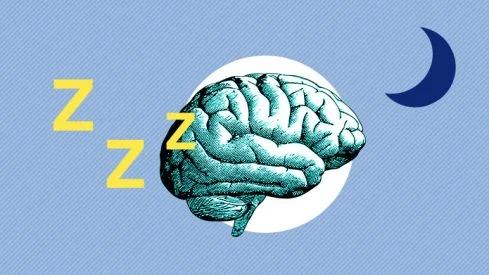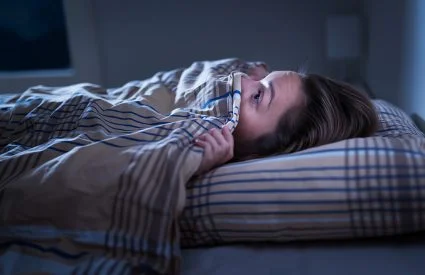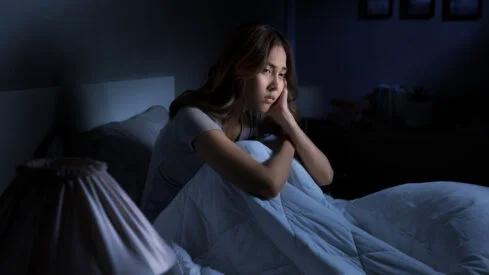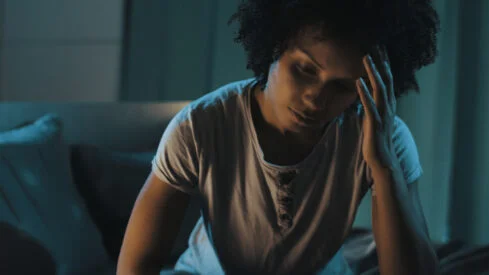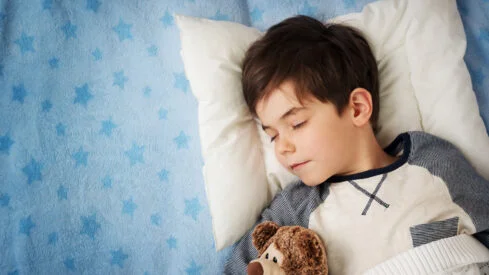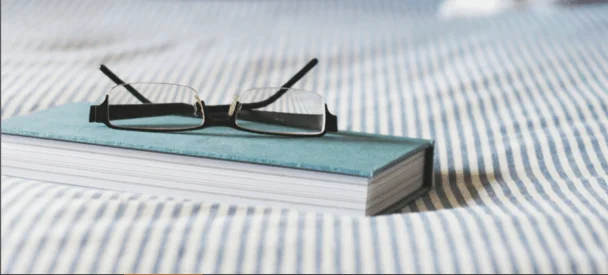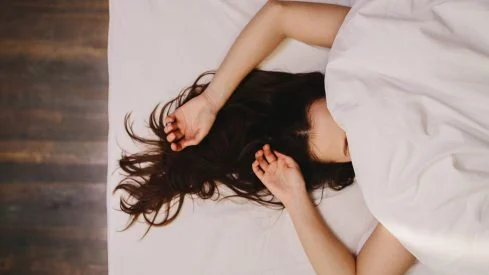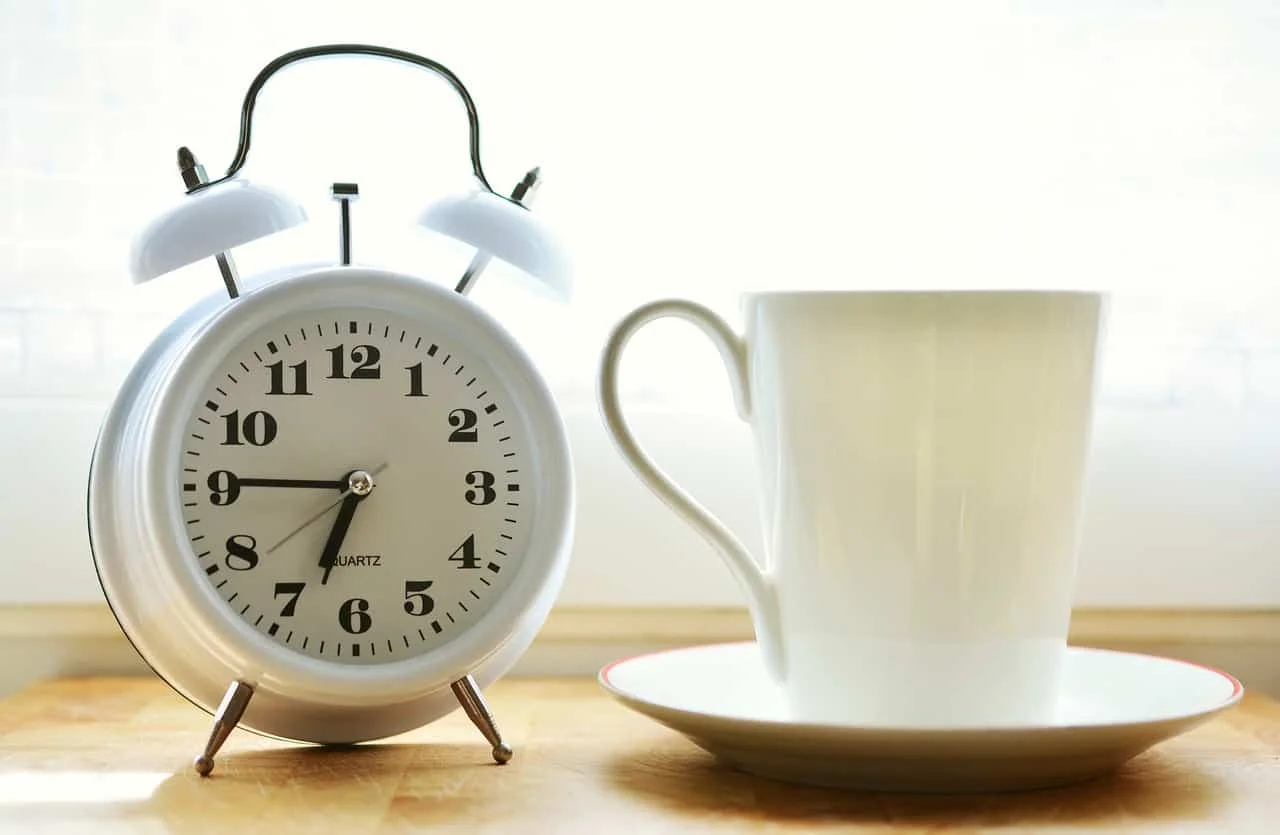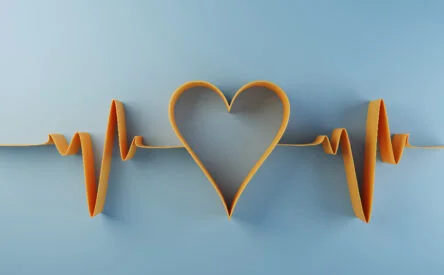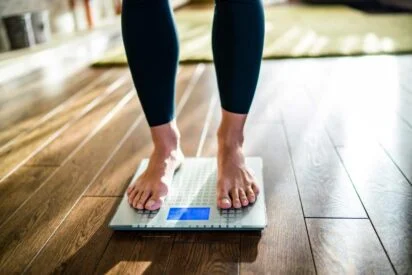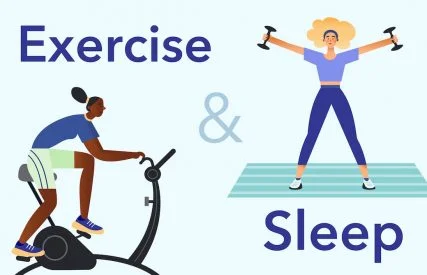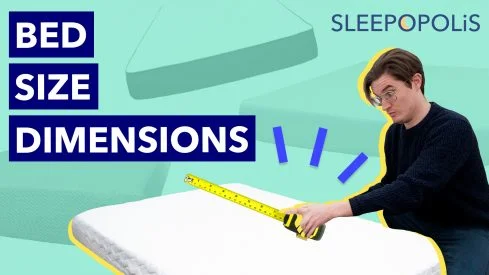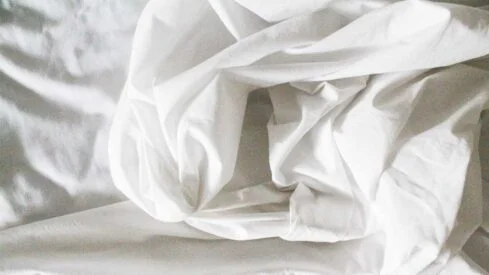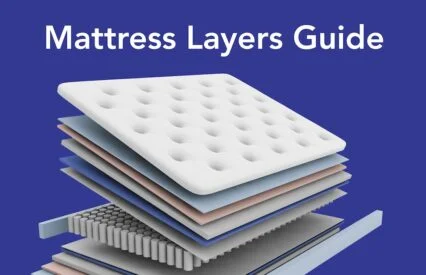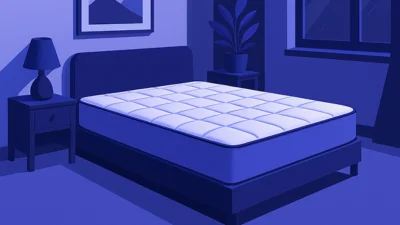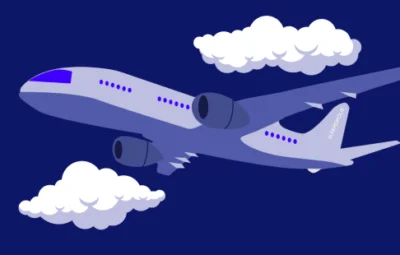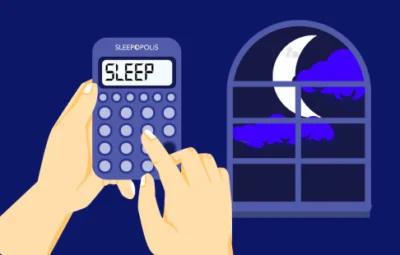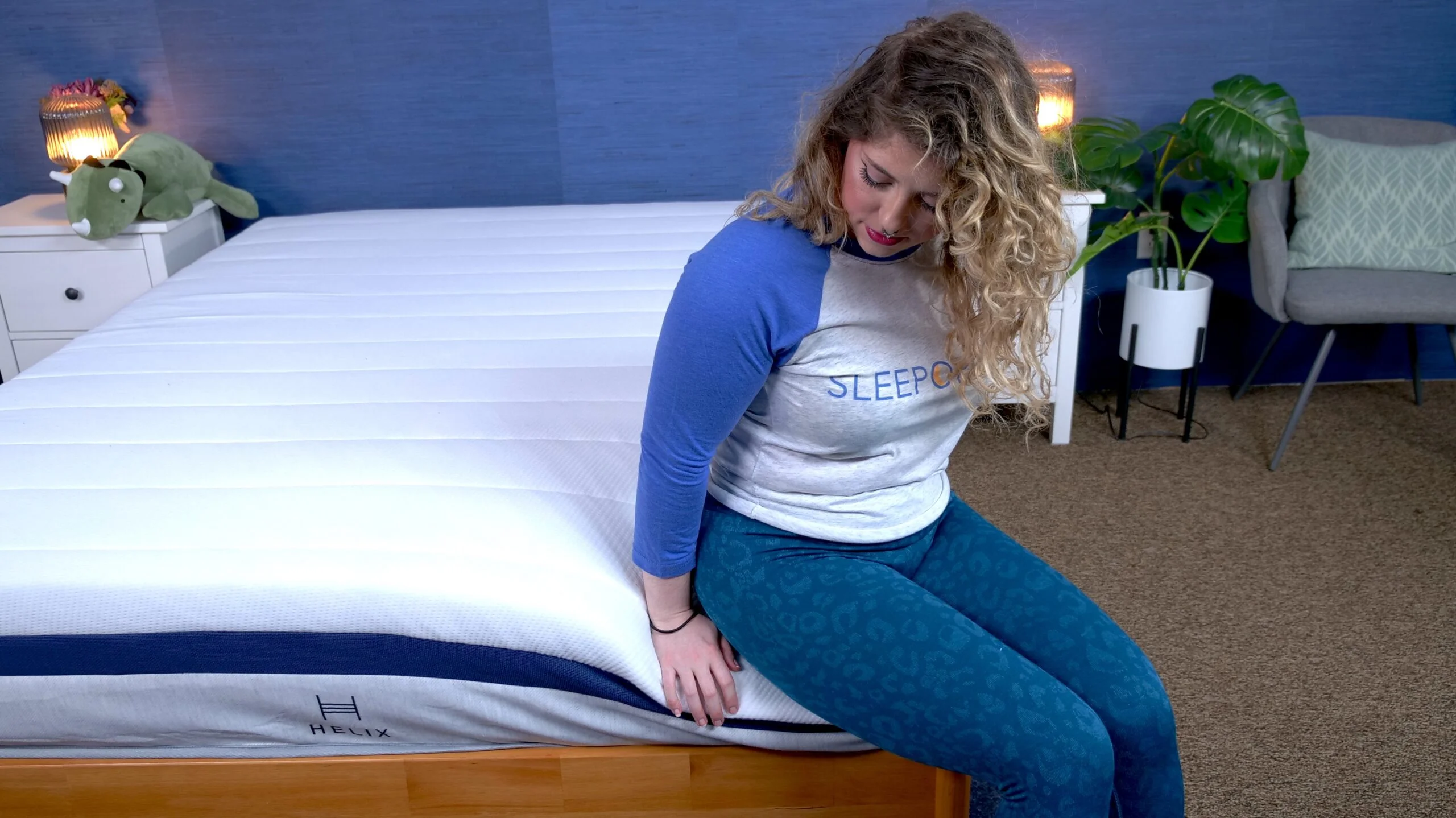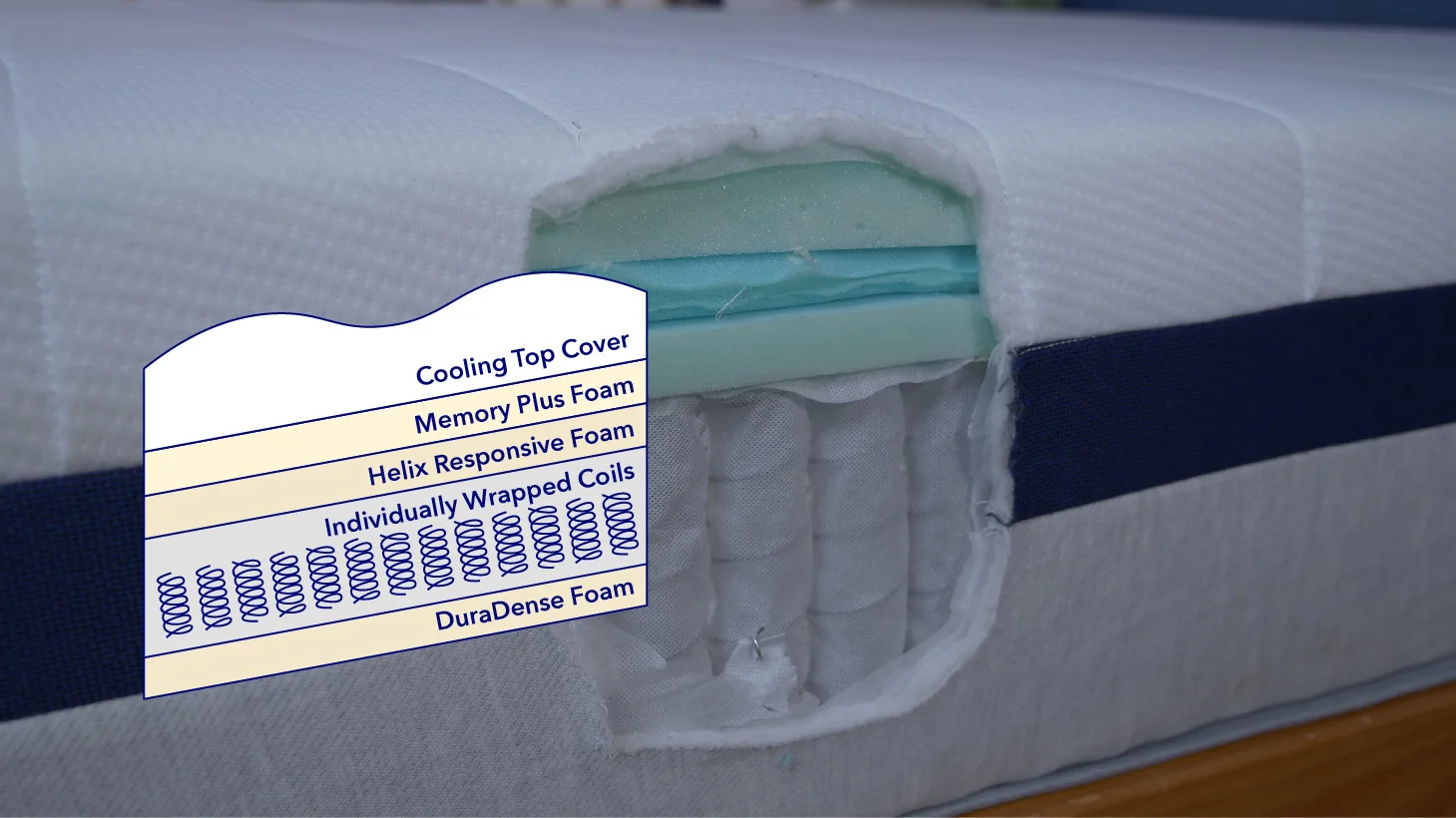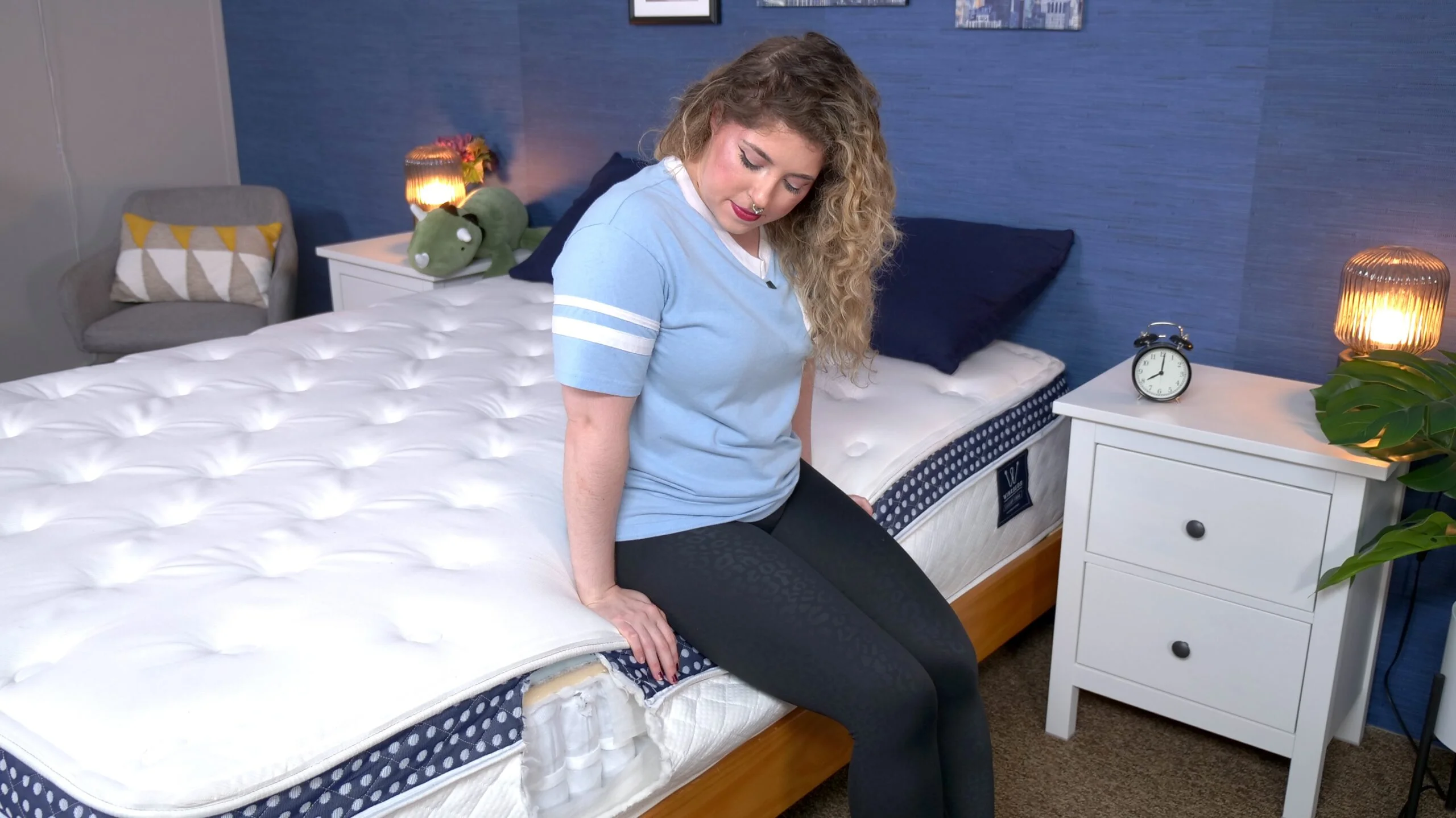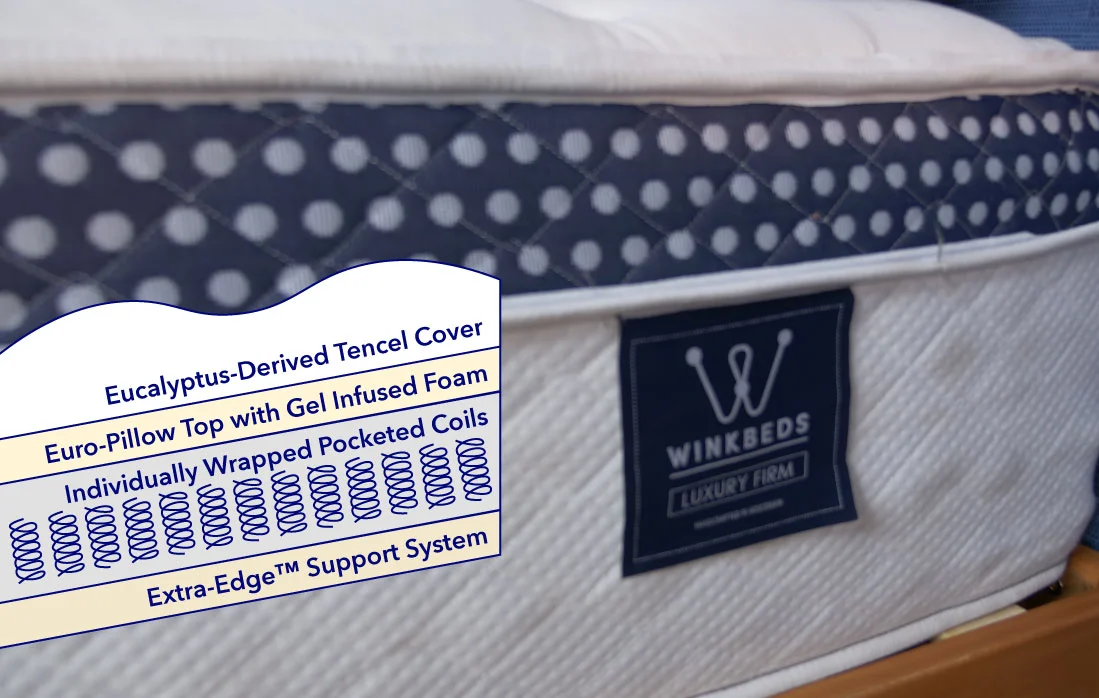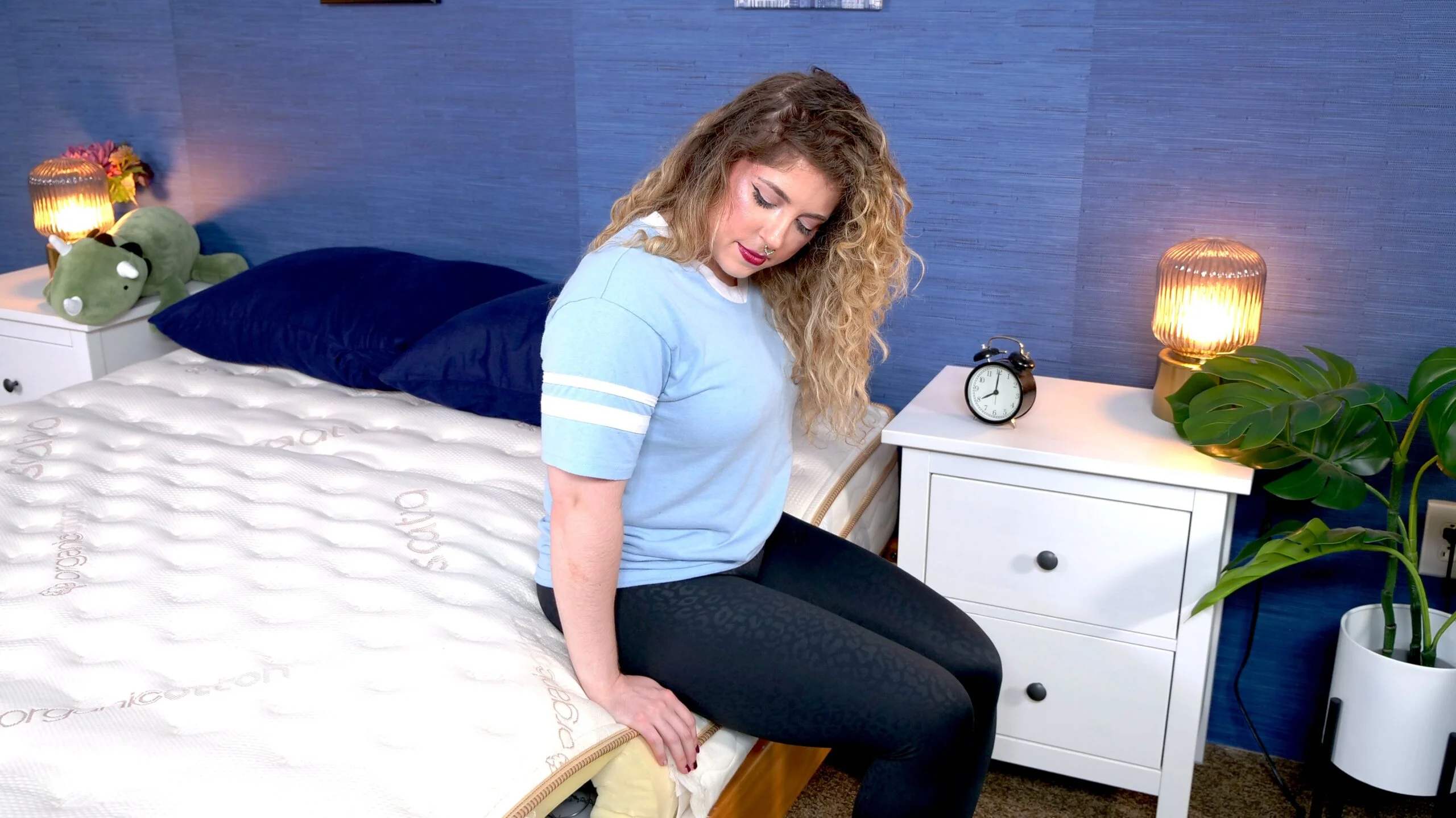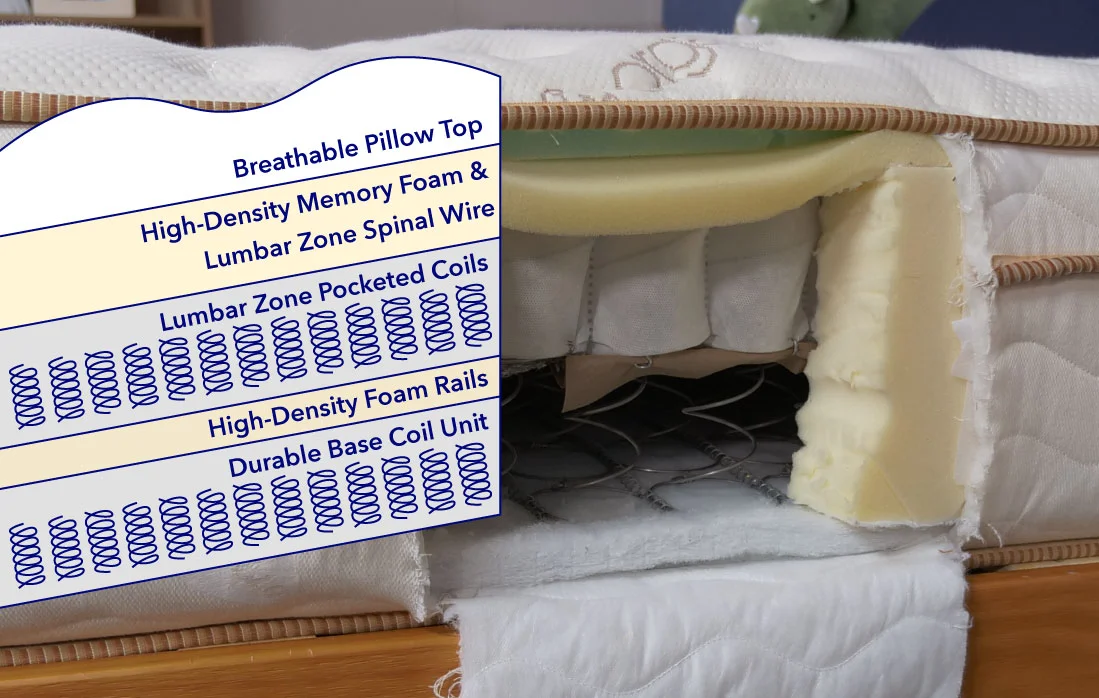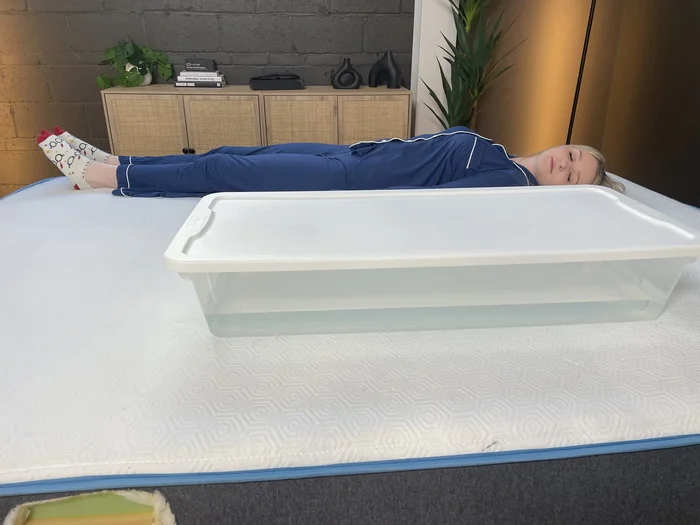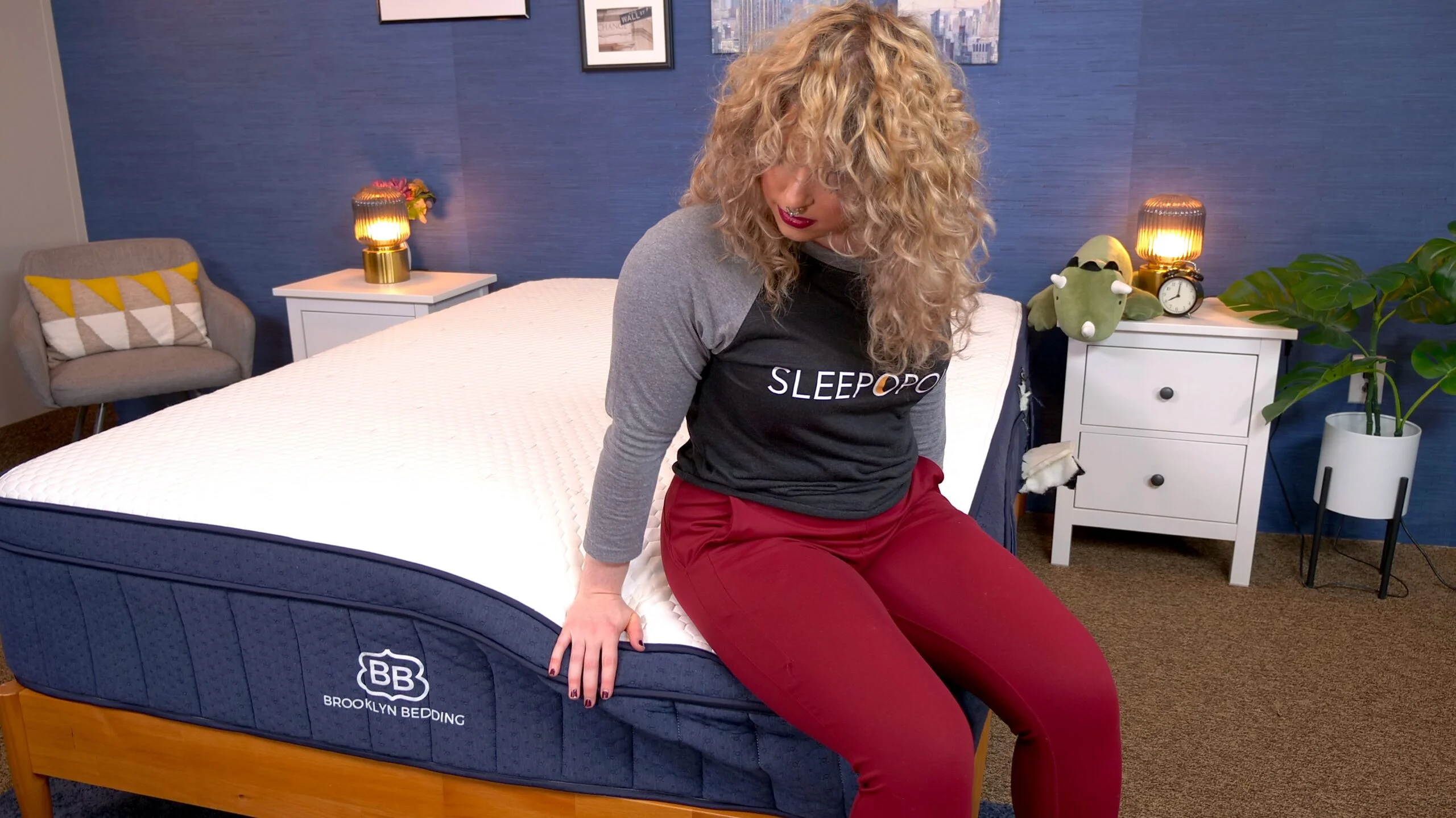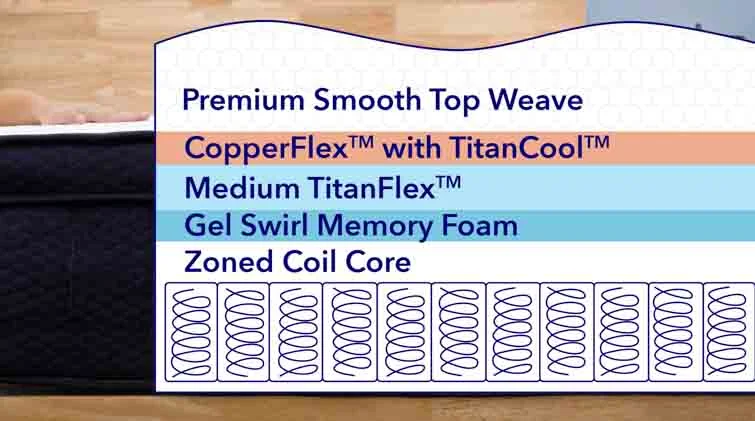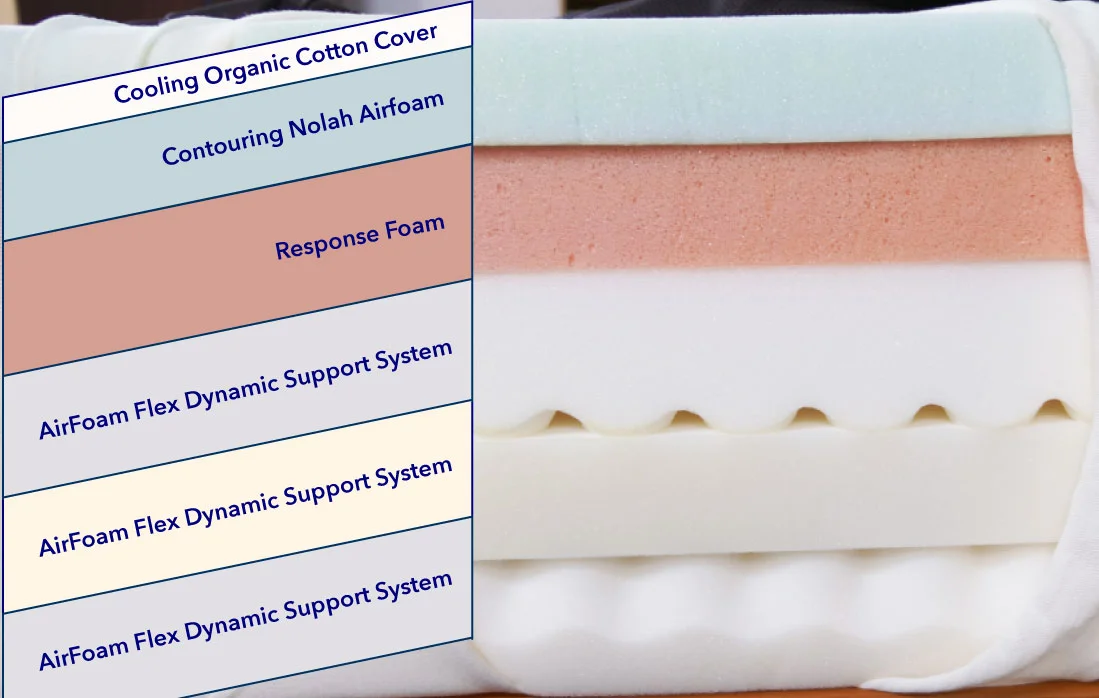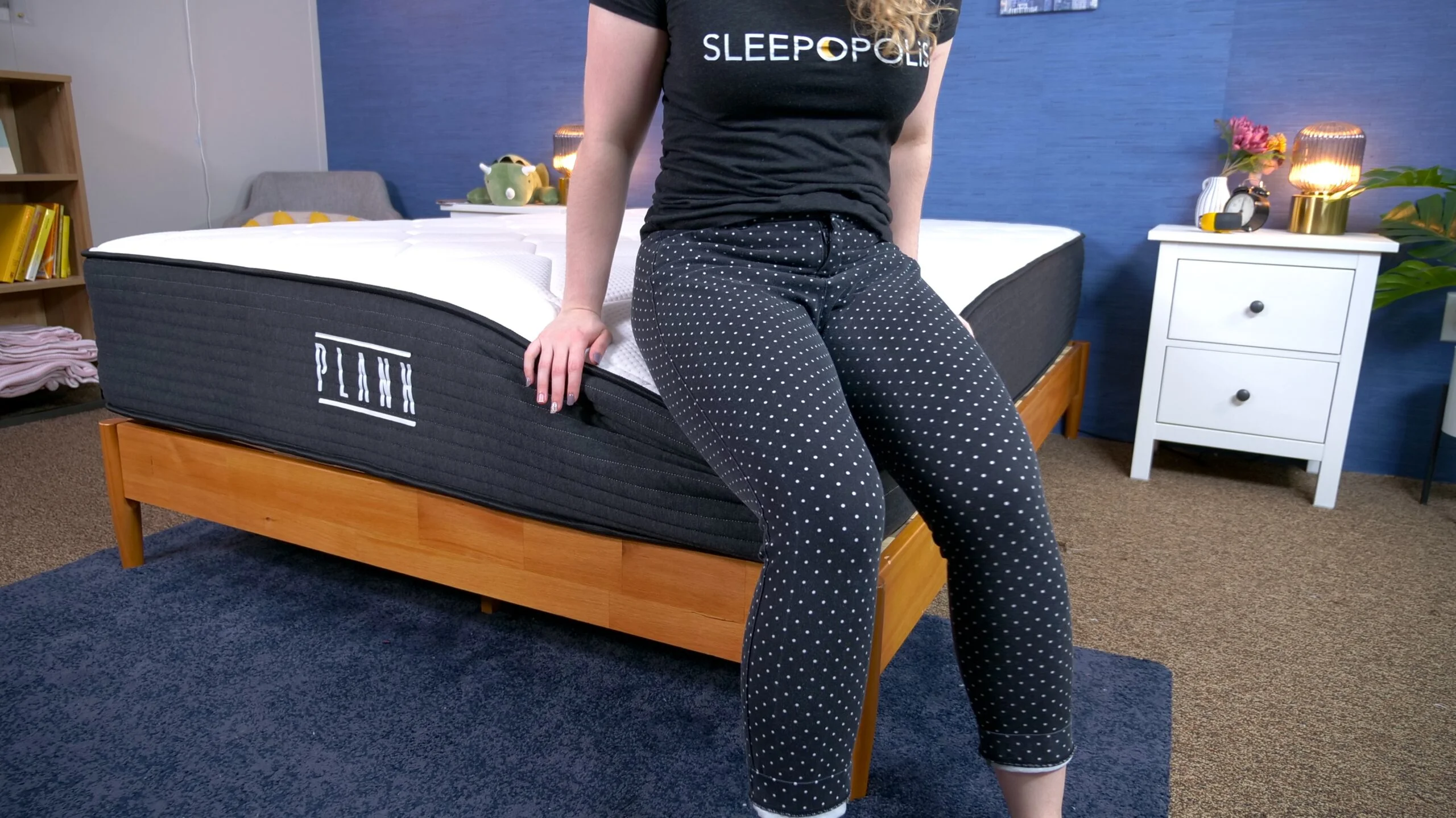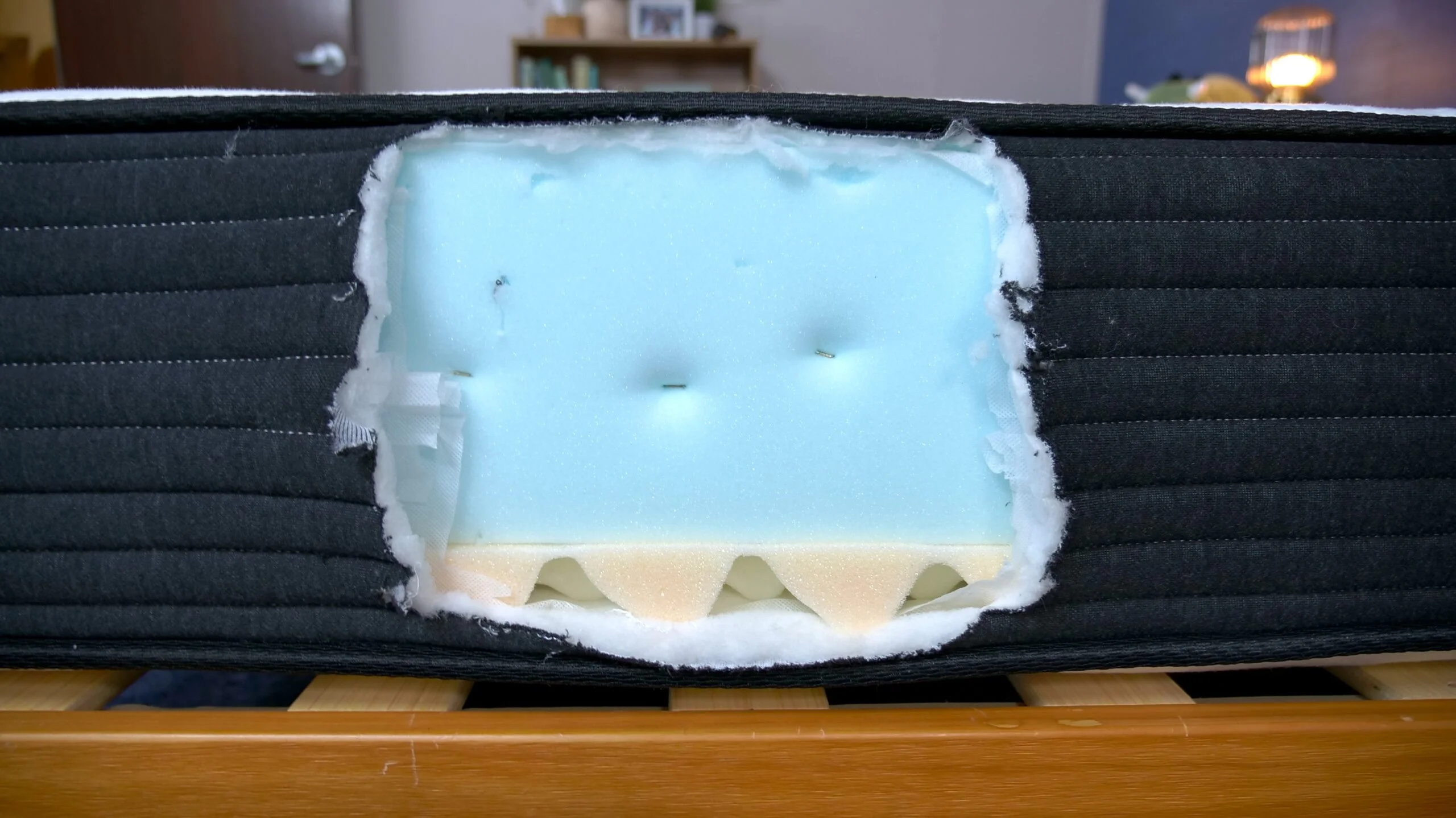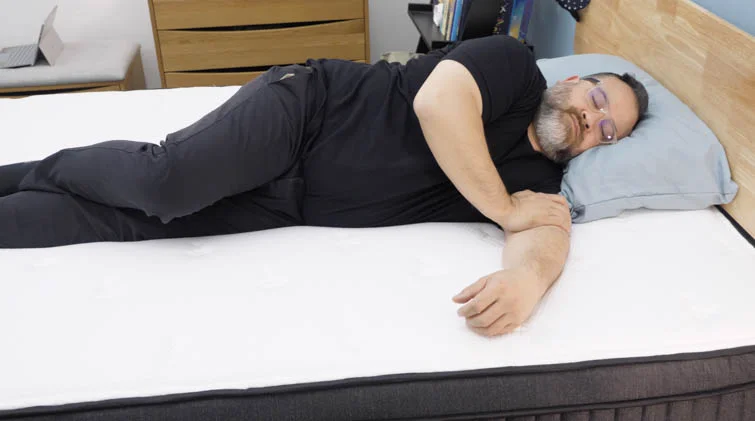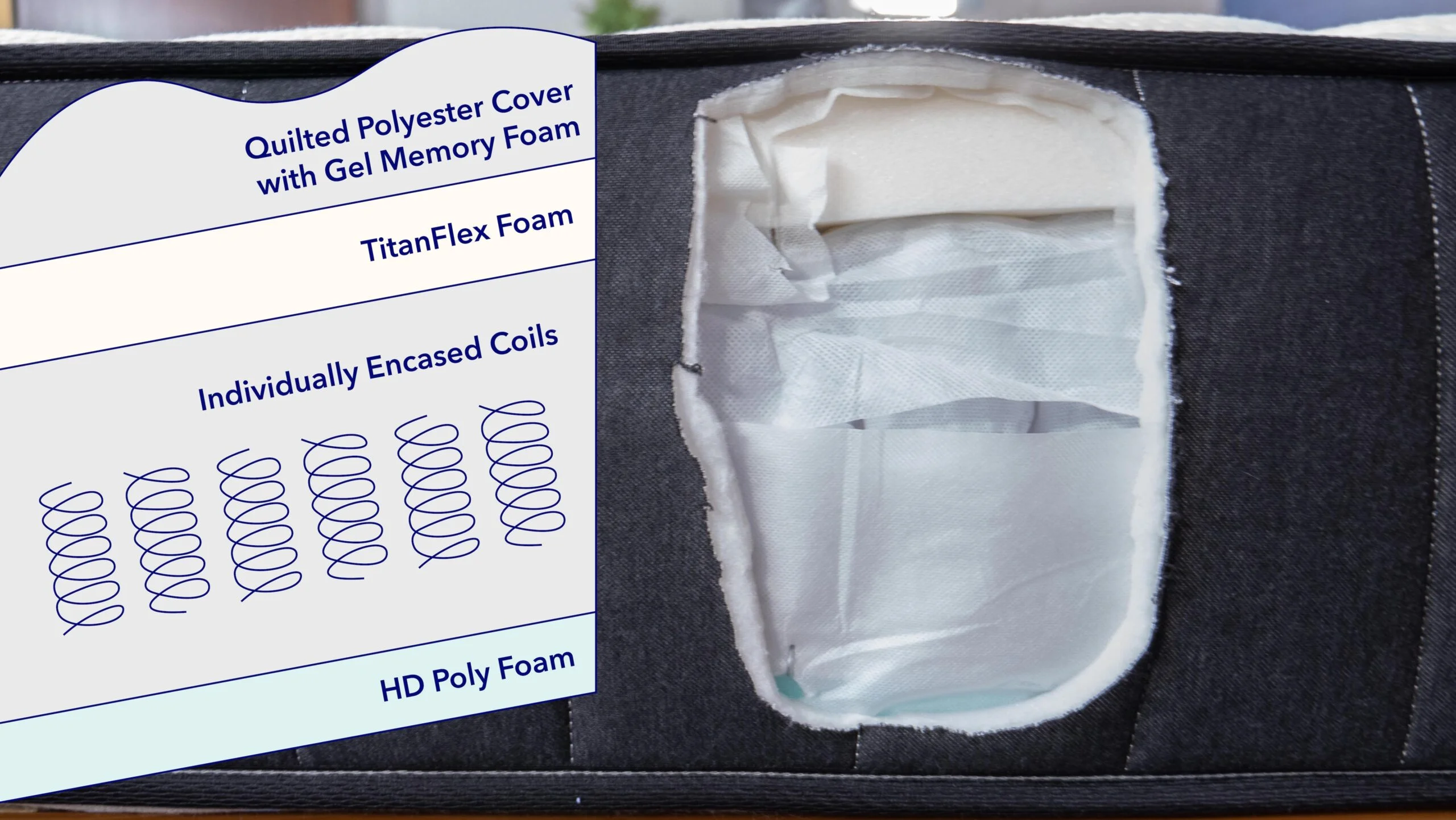Back pain is one of the most common sleep-related issues that affects people of all ages and lifestyles. In fact, up to 80% of adults will experience back pain at some point in their lives. One potential cause of this discomfort is spinal stenosis, a condition where the spaces in your spine narrow, putting pressure on the nerves and leading to pain, numbness, or weakness.
It’s important for folks suffering from spinal stenosis to choose the right mattress, because one that doesn’t provide adequate support can exacerbate pain and discomfort. Too much softness can lead to poor spinal alignment, increasing pressure on the back and worsening symptoms.
According to Dr. Raj Dasgupta, Sleepopolis’ Chief Medical Advisor, “If your mattress is too soft and doesn’t give your spine enough support, it can make your spinal stenosis symptoms worse. Look for a mattress that’s at least medium firm, is supportive, and relieves any pressure points that are bothering you.”
That’s why I’ve put together this roundup to help you find the best mattresses for spinal stenosis. Throughout 2024, Sleepopolis helped over 12,500 people find the right bed, and now I’m here to guide you in selecting a mattress that supports your spine through the night.
These mattresses range in price from $1,300 to $2,300 for a queen size, giving you a variety of options that fit different budgets without compromising on support or comfort. I’ve tested each mattress carefully using a pressure-map test, which shows how much pressure a mattress exerts on the body in different sleeping positions. The best mattresses for spinal stenosis will show little to no pressure in all positions, helping to reduce pain and keep your spine aligned. Let’s dive in and see which beds made the cut!
Sleepopolis’ Best In Rest —Spinal Stenosis
I chose the WinkBed as the best mattress for spinal stenosis due to its high level of support. Its innerspring coils should give you a lift when you lie down and help keep the spine neutrally aligned.
Best Mattresses for Spinal Stenosis of 2025
- Helix Midnight – Best Overall Mattress for Spinal Stenosis
- WinkBed – Best Luxury Mattress for Spinal Stenosis
- Saatva – Best Innerspring Mattress for Spinal Stenosis
- Bear – Best Memory Foam Mattress for Spinal Stenosis
- Brooklyn Bedding Aurora Luxe – Best Hybrid Mattress for Spinal Stenosis
- Nolah Signature – Best Mattress for Back Sleepers with Spinal Stenosis
- Plank Firm – Best Firm Mattress for Spinal Stenosis
- Titan Plus – Best Mattress for Heavier People with Spinal Stenosis
Disclaimer: The content on Sleepopolis is meant to be informative, but shouldn’t replace advice or treatment from a medical professional. If you experience chronic pain or discomfort while sleeping, it’s best to consult a healthcare professional.
Need help finding the right mattress?
Compare the Best Mattress for Spinal Stenosis

|
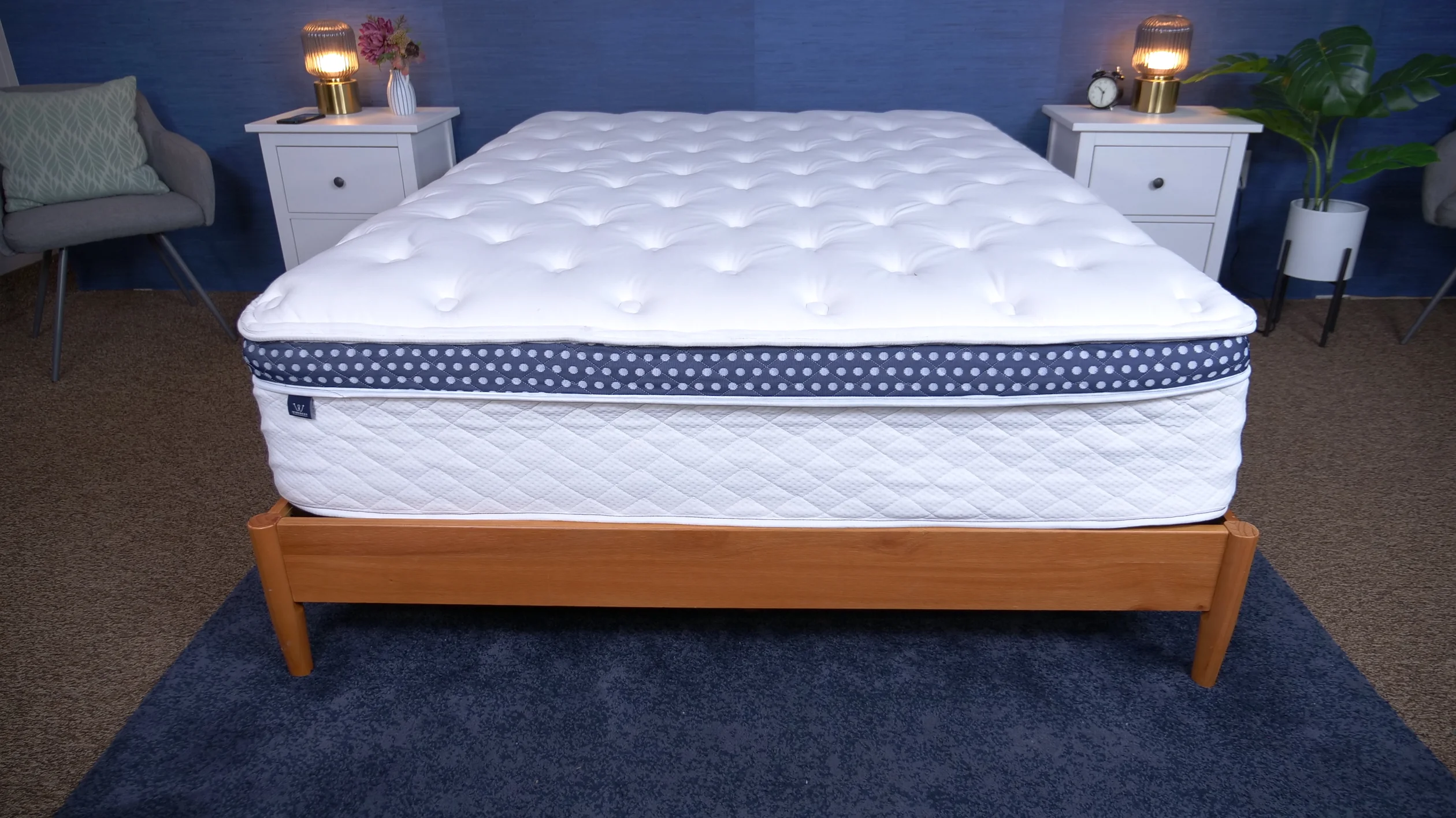
|
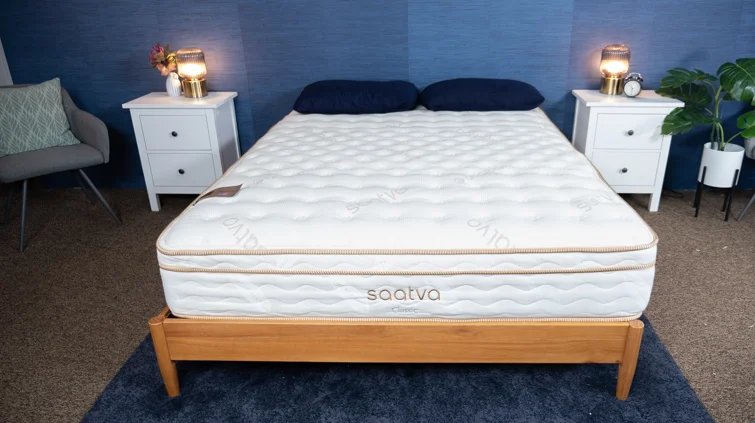
|
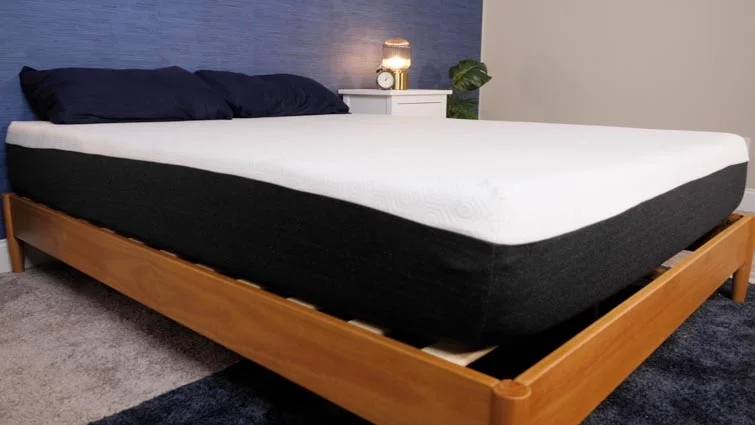
|

|

|
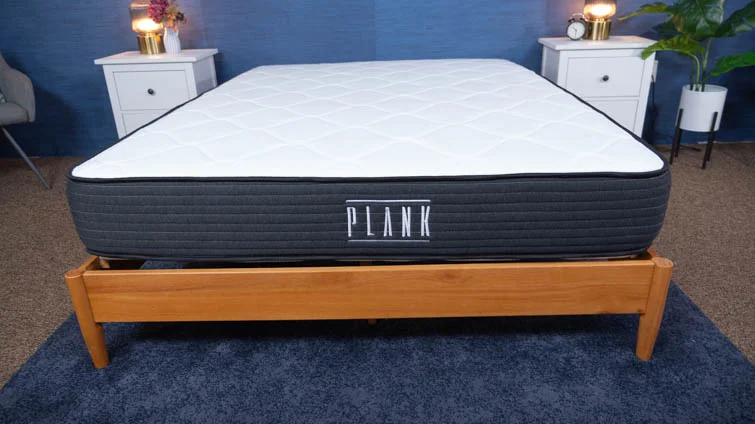
|
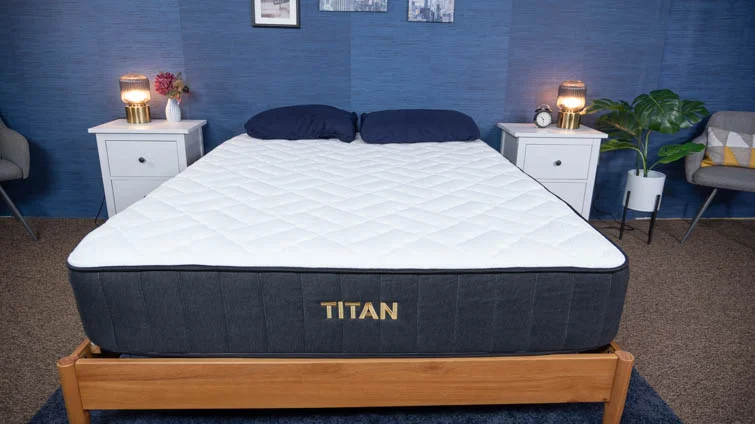
|
|
| Helix Midnight Mattress | WinkBed Mattress | Saatva Classic | Bear Original Mattress | Brooklyn Bedding Aurora Luxe Mattress | Nolah Signature 12″ Mattress | Brooklyn Bedding Plank Firm Mattress | Titan Plus Core | |
| Rating | ||||||||
| Firmness | Medium-firm: 6.5/10 | Firm: 7/10 | Multiple firmness options | Firm: 7/10 | Multiple firmness options | Soft: 5.5/10 | Multiple firmness options | Firm: 7.5/10 |
| Material | Hybrid | Hybrid | Innerspring | Foam | Hybrid | Foam | Foam | Hybrid |
| Cooling | — | — | — | — | ||||
| Best For |
Side Sleepers,
Back Sleepers, Couples |
Side Sleepers, Back Sleepers, Stomach Sleepers, Hot Sleepers, Back Pain
|
Back Sleepers, Stomach Sleepers, Hot Sleepers, Back Pain, Seniors
|
Back Sleepers, Stomach Sleepers, Hot Sleepers, Hip Pain
|
Back Sleepers, Stomach Sleepers, Hot Sleepers, Back Pain, Couples
|
Side Sleepers,
Back Pain |
Back Sleepers, Stomach Sleepers, Back Pain, Seniors
|
Back Sleepers, Stomach Sleepers, Back Pain, Hip Pain, Seniors
|
Helix Midnight – Best Overall Mattress for Spinal Stenosis
The Helix Midnight is amongst Helix’s line of six standard mattresses. It’s known for its more balanced feel, allowing it to accommodate a wide range of sleepers. We also recommend it for couples, as it scored well on our motion isolation, responsiveness, edge support, and cooling tests. For a plusher and more cooling version of this mattress, see the Helix Midnight Luxe. Learn more in our video review.
What our tester says:
“I would recommend this mattress for side or back sleepers because it’s supportive, without putting pressure on your joints.” – Nichole Mondshein, lead reviewer and staff writer
Expert Opinion
If you’re looking for the best mattress for spinal stenosis, but are on a strict budget, you might want to consider the Helix Midnight — a bed whose combination of pressure relief and affordability led us to choose it as our best overall pick. After discounts, this model is usually available for close to or under $1,000 for a queen size. It has a comfort layer of Memory Plus foam (a more responsive alternative to memory foam) for both ease of movement and contouring. At the bottom of the mattress, a layer of coils uses a zoned support system that’s meant to give you proper weight distribution, and can help prevent the back pain that comes with spinal stenosis.
When testing out the Helix Midnight, I rolled out our specialized pressure mat and was pleased to see that there was little to no pressure on my back. That being said, I think the bed’s medium-soft to medium-firm feel (it scored between a 6 and 6.5 out of 10 on our mattress firmness scale) is a better fit for back sleepers and side sleepers than it is for stomach sleepers.
WinkBed – Best Luxury Mattress for Spinal Stenosis
The WinkBed is a luxury hybrid mattress. It has a similarly supportive and sturdy feel to a traditional innerspring mattress, but upgrades like a Euro top and cooling Tencel cover give it a touch of modern luxury. Available in three firmness levels, there is a WinkBed for just about every sleeper. And a responsive and bouncy feel makes it a great pick for combination sleepers. Learn more in our video review.
What our tester says:
“If you like the feel of a traditional innerspring mattress, the WinkBed could work for you. Since this bed offered great pressure relief around my lumbar region, I’d also recommend it to folks who suffer from lower back pain.” – Nichole Mondshein, lead reviewer and staff writer
Expert Opinion
A luxury hybrid mattress with a traditional innerspring feel, the WinkBed is outfitted with a layer of extra-tall coils. These coils are also zoned, meaning that they’re firmer in certain spots of the bed and softer in others, depending on how much support is needed. This helps create an optimal spinal position during sleep — a crucial trait for anyone dealing with tension from spinal stenosis. That’s why I’ve chosen the WinkBed as my best luxury pick. The WinkBed also has a reinforced edge that makes the mattress incredibly durable and stable. When testing it out, I was able to effortlessly get in and out of bed, thanks to the coils’ strength and responsiveness. Additionally, I was able to easily change positions.
One of the most crucial tests I perform when recommending the best mattress for spinal stenosis is the pressure-map test. It involves spreading a specialized mat across the mattress, which then uses thermal imaging to show how much pressure I’m putting on a bed when I lie down on it. Blue equates to no pressure, green is little pressure, yellow is moderate pressure, and orange and red are high pressure. On the WinkBed, the back area lit up bright-blue, indicating little to no pressure, and once again telling me that this is a good mattress for anyone with spinal stenosis.
Note: the WinkBed comes in several different firmness levels. I tested out the Luxury Firm.
Saatva – Best Innerspring Mattress for Spinal Stenosis
The Saatva’s coil-on-coil construction provides a classic innerspring feel. It’s a good option for combo sleepers, who will want to feel free to switch positions and avoid feeling “stuck” in the mattress. It comes in three firmness levels, so you should be able to find one that suits your needs. The white glove delivery Saatva provides is an added perk and will save you the headache of getting rid of your old mattress (they take it away for free!). For more information, watch our video review.
What our tester says:
“I think the Saatva is a great option for back sleepers, as the Luxury Firm model provides enough cushioning for their lumbar region, but also lots of support to keep their spine in a neutral alignment.” – Nichole Mondshein, lead reviewer and staff writer
Expert Opinion
When looking for the best mattress for spinal stenosis, you should definitely consider the Saatva. It has a traditional innerspring feel, thanks to its coil-on-coil construction (it essentially has two layers of springs). These coils deliver a ton of support and help distribute weight across the entire surface of the bed. This can help fight tension build-up in the spine. Another perk of the springs is that they don’t make sleepers feel stuck. So if your spinal stenosis is making it hard to get out of bed due to pain, it will be a bit easier with the Saatva.
The Saatva comes in three different firmness levels, and I tested out the Luxury Firm. I felt myself sinking into the bed’s euro top enough to feel pressure relief that may help with spinal stenosis. The coils underneath, especially around the hips, felt sturdy, and my back and neck stayed aligned. I also put the mattress through the pressure-map test, during which it showed almost no pressure around the back while back-sleeping. There was a little bit of pressure in this area while side-sleeping and stomach-sleeping, but this likely won’t be the case on the other models (side sleepers should opt for the Plush Soft and stomach sleepers should go with the Firm).
Bear – Best Memory Foam Mattress for Spinal Stenosis
Even though it’s made entirely of foam, the Bear has a firm, supportive feel that should be sturdy enough for back sleepers and stomach sleepers alike. Additionally, combination sleepers should be able to easily move around on its surface. You can also pay extra for a Celliant cover that may help with cooling and muscle recovery. Learn more in our video review.
What our tester says:
“While the Bear offers a bit of cushioning from the memory foam comfort layer, we felt a lot of lift from deep within the mattress. This firmer-than-average feel and construction provided the best spinal alignment, pressure relief, and comfort in the back- and stomach-sleeping positions.” – Riley Otis, staff writer and certified sleep science coach
Expert Opinion
While the deep pressure relief of memory foam can provide some respite from spinal stenosis, you don’t want the bed to be too soft, which can often result in a lack of adequate support. That’s why I’ve chosen the Bear mattress as the best memory foam mattress for spinal stenosis. Even though it has some soft memory foam up top, it has a strong base of high-density support foam that gives the bed a medium firmness. If you suffer from spinal stenosis, you should get some contouring in the lumbar region while still receiving enough support for a neutral spinal alignment.
Of course, I had to look a our pressure map results before putting the Bear on this list. Luckily, the graphic was almost entirely blue in each sleeping position, indicating little to no pressure buildup — another plus for anyone with spinal stenosis.
Brooklyn Bedding Aurora Luxe – Best Hybrid Mattress for Spinal Stenosis
The Brookyn Bedding Aurora Luxe mattress is one of Brooklyn Bedding’s more high-end mattresses. It’s got a ton of cooling features in it that can help hot sleepers sleep cool all night. It’s also available in three different firmnesses, so it can accommodate all of the sleeping positions. For more information, check out our video review.
What our tester says:
“First and foremost, I’d recommend this mattress to hot sleepers. This bed sleeps nice and cool thanks to special phase change technology and gel infusions. The Aurora Luxe is also a nice pick for back sleepers. This mattress in the Medium model is medium-soft, so it should contour the hips while also lifting them into alignment.” – Nichole Mondshein, lead reviewer and staff writer
Expert Opinion
A hybrid mattress can be a good option for sleepers with spinal stenosis due to the bed’s dynamic construction. The coils are ddesigned to provide sturdy support while the foams offer up pressure relief. That’s certainly the case with the Brooklyn Bedding Aurora Luxe, a luxury hybrid built with three layers of foam supported by a bottom layer of zoned coils. “Zoned” means the springs are firmer in certain places and softer in others, giving you spinal support where you need it the most.
While lying on the Aurora Luxe, I found it to be medium firm, giving me some contouring at my lower back while keeping my spine lifted and aligned. The pressure map confirmed this feeling, especially when I was on my back. In this sleeping position, the graphic was almost entirely blue, indicating little to no pressure buildup. I also loved indulging in this mattress’s luxurious features, from the infusions of gel and copper in the foam (both of which help with cooling) to the smooth top weave of the cover.
Nolah Signature – Best Mattress for Back Sleepers with Spinal Stenosis
If you’re looking for a soft yet supportive foam option, the Nolah Signature should be a good fit. It’s supportive enough for back sleepers, while also providing enough contouring for side sleepers, especially at the shoulders and hips where the put the most pressure while sleeping. Learn more in our video review.
What our tester says:
“I think the Nolah Signature is a great choice for a lot of back and side sleepers. The sinkage this mattress provides should be a nice match for these sleepers and offer the pressure relief they need.” – Bridget Chapman, former senior product editor
Expert Opinion
If you’re a back sleeper who struggles with spinal stenosis, it can be beneficial to seek out a mattress with a mixture of comfort and support — pressure-relieving enough to relieve any pain, yet sturdy enough to keep you lifted and stop you from sinking too far into a mattress’s layers. You might find just that in the Nolah Signature, which uses ultra-soft AirFoam in the comfort layer for added contouring. When I laid down on the bed, I could feel the foam relieving pressure at my lower back (for context, I ranked the Signature at a 5.5 out of 10 on our mattress firmness scale). At the same time, I still got enough of a lift for a neutral spinal alignment. When I ran the bed through my pressure-map test, the graphic was mostly blue on the back, indicating low pressure while back sleeping.
Interestingly, the Signature is available in two different models: all-foam and what they’re calling a foam hybrid. While this hybrid doesn’t have any springs, there’s a support layer of “micro-cut wave” foam designed to respond like springs. I think back sleepers should be comfortable on either option.
Plank Firm – Best Firm Mattress for Spinal Stenosis
The Plank Firm more than lives up to its name with its ultra-sturdy foams and supportive feel. While this bed certainly isn’t for everyone, it should be an ideal fit for back sleepers, stomach sleepers, and combination sleepers who want to feel more on top of their mattress than in it. For more information, check out our video review.
What our tester says:
“I think the Plank Firm is one of the best mattresses for stomach sleepers. Both sides of the mattress, the firm side and extra firm side, should give these sleepers the support they need to keep their hips in line with their shoulders. Back sleepers who like a firmer feel should also be happy on the firm side of the Plank.” – Nichole Mondshein, lead reviewer and staff writer
Expert Opinion
The Plank is a flippable all-foam mattress from Brooklyn Bedding with both a Firm and an Extra-Firm side. I think both sides could be a good option for sleepers with spinal stenosis, as long as they prefer a firm mattress. When lying on it, I felt my spine aligned and my hips supported, which eased muscle tension. And despite this bed being one of the firmest mattresses I’ve ever tested, I didn’t see any pressure buildup near my back when we ran the bed through our pressure map test — and that was for all three sleeping positions. That said, I don’t recommend a mattress this firm for side sleepers, who tend to need extra contouring at the shoulders and hips.
Titan Plus – Best Mattress for Heavier People With Spinal Stenosis
The Titan Plus mattress is a durable mattress made with heavy sleepers in mind. It’s firm and features heavy-duty coils and Titanflex foam that makes it bouncy and easy to move around on. We think that heavy back sleepers and stomach sleepers should be especially comfortable. For more information on the Titan Plus, check out our video review.
What our tester says:
“I think the Titan Plus lives up to its name as a good mattress for heavier sleepers. It will offer them the deep compression support and durability they need.” – Nichole Mondshein, lead reviewer and staff writer
Expert Opinion
If you have spinal stenosis and weigh 230 pounds or more, a mattress with strong support becomes doubly important. Fortunately, Brooklyn Bedding has created the Titan Plus, a bed built specifically with heavy people in mind. Its durable materials include an extra-tall layer of coils, topped by a thick layer of ultra-dense TitanFlex foam. And for added pressure relief, there’s a cover quilted with memory foam.
To test the Titan Plus, we enlisted a powerlifter named Paulie Steinman. He found the mattress to be pressure relieving yet supportive — the exact combination you want if you suffer from spinal stenosis. He said the mattress was comfortable in all three sleeping positions, especially on his back and stomach.
Hear From the Experts: What are the Primary Qualities You Would Look For in a Mattress to Help with Spinal Stenosis?
“To help alleviate some of the symptoms of spinal stenosis, choose a medium-firm to firm mattress that gives plenty of support for your lower back. It should be made of contouring materials (such as memory foam or latex) and relieve pressure points. If it’s adjustable, that could be a bonus, and make sure the mattress is durable and will last.” – Dr. Raj Dasgupta MD, FACP, FCCP, FAASM. Quadruple-board certified in pulmonary, sleep, internal, and critical care medicine
What Exactly Is Spinal Stenosis?
To pick the best mattresses for spinal stenosis, it’s important to understand what you’re dealing with first.
Simply put, spinal stenosis is a condition that involves the narrowing of the spaces in your spine. The narrower they get, the more likely it is for the nerves to become compressed or pinched. According to Dr. Debra Sullivan, this occurs either in the cervical part of your spine (neck) or in the lumbar part of your spine (lower back). Therefore, there are two types of spinal stenosis, cervical stenosis, and lumbar stenosis. As a result of the nerve compression that occurs in spinal stenosis, you may start experiencing numbness, weakness, and pain in your legs and feet, plus back pain if you are experiencing lumbar stenosis or neck pain if you are experiencing cervical stenosis.
Spinal stenosis cases are growing in number these days. It can be either congenital (from birth) or acquired. Congenital cases are usually caused by a small spinal canal. In acquired cases, it can be caused by either age-related spinal changes or by other conditions such as injuries or previous spinal surgery, bone wear and tear, excess calcium or fluoride, scoliosis, or other illnesses.
“If you are experiencing any of the symptoms listed above and think you may have spinal stenosis, but have not had a diagnosis, we recommend speaking with your healthcare provider, as it could be caused by a more serious issue,” says Dr. Sullivan. One of the risk factors is age-related degenerative change, which explains why spinal stenosis is more common among people over 65.
Since spinal stenosis can cause neck, back and limb pain, this condition might make it challenging to get a good night’s sleep. Additionally, you may even start experiencing more pain due to the lack of movement and staying in one position for a long time during the night. The lack of motion during sleep puts more pressure on the joints and your spine. As a result, your stenosis symptoms can worsen.
And that’s why it’s so important to get yourself a proper mattress for spinal stenosis. While it can’t treat the condition, a suitable bed has a chance of making you feel more comfortable and relaxed, and thus improve your sleep quality. Plus, a proper mattress may even help relieve the pain.
What Causes Spinal Stenosis?
According to the Mayo Clinic, the most common causes of spinal stenosis are age-related changes, such as osteoarthritis, which is a gradual wear and tear of the joints that can cause extra bone to grow on the spine. Other causes include bone spurs, which is an extra bone growth, tumors growing on the spine, herniated disks, and other spinal injuries. Some people are also born with smaller spinal canals.
We recommend consulting your doctor or another medical professional to understand the cause of your spinal stenosis, or for an official diagnosis. There are a lot of other causes of back pain or discomfort that may not be spinal stenosis, so it is always important to talk with a physician or doctor about what you are experiencing.
Can a Mattress Help with Spinal Stenosis?
A mattress cannot cure spinal stenosis, and we recommend seeking medical help if you are experiencing severe pain or problems associated with your spinal stenosis. What a mattress can do, however, is provide support, pressure, and pain relief. A mattress that supports proper spinal and hip alignment, and provides the necessary pressure relief across the spine can help you sleep more comfortably and alleviate some discomfort and pain.
What Is the Best Type of Mattress for Spinal Stenosis?
A good mattress is supposed to distribute your weight evenly and keep your spine properly aligned during the night. While this is the main rule when finding the best mattress for spinal stenosis, some extra characteristics may vary depending on the materials used.
Let’s look at the most common ones and see which material can make the most suitable mattress for spinal stenosis.
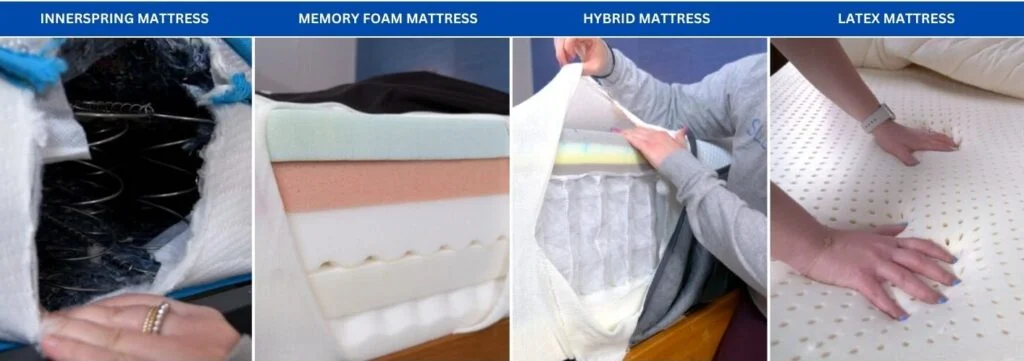
Memory Foam
Whether it’s memory or polyurethane foam, this material offers close conforming and adapts its surface to the curves of your body. It effectively distributes your weight, which aids spinal alignment. This makes foam mattresses a good option for lumbar spinal stenosis, which is often accompanied by kyphosis that requires a correct sleeping posture. The cradling properties of foam also help with pressure relief. This, consequently, can help reduce the pain levels.
The main drawback sleepers usually have to deal with is sleeping hot. Foam tends to trap body heat while giving you a generous hug. All of that can make you wake up sweaty in the morning. Now, if you don’t want to sacrifice the superb pressure relief that these mattresses offer, you may want to consider models that use gel infusion or an open-cell technology for a cooling effect.
Hybrid
Hybrid mattresses combine pocketed coils for base support and foam (or sometimes latex) for comfort layers. This type offers the best of both materials: sturdy support and good air circulation (coils) with pressure relief (foam or latex).
Hybrid beds are a good option for sleepers with spinal stenosis due to their balanced feel. Such a mattress would be supportive enough to aid proper spinal alignment while gently cradling your body and reducing pressure points.
However, keep in mind that hybrid models are usually quite expensive. They also tend to be very heavy and hard to move. And because of the multiple layers used, many hybrid mattresses are quite thick. If your spinal stenosis pain causes mobility issues, an overly tall mattress can make it hard for you to get in and out of bed every day. Check out our best hybrid mattress picks.
Latex
Latex mattresses have a fast response, so they aren’t supposed to make you feel stuck. At the same time, the material does a great job of relieving pressure and tension, helping your muscles relax, and reducing stress on the joints. This can help alleviate the pain caused by spinal stenosis.
Another benefit of latex mattresses is that they don’t sleep hot. And while this factor isn’t directly linked to spinal stenosis pain, it can help you feel much more comfortable and relaxed, which may improve your sleep quality.
Innerspring
Using coils for support, innerspring beds are quite bouncy and responsive. Such mattresses often use a thin layer of foam for improved comfort, but it’s not usually enough for decent pressure relief. That’s why this type is more suitable for back and stomach sleepers rather than side sleepers.
At the same time, innerspring beds allow for consistent support across their surface. They also have strong edges, which can make them a good option for a mattress for cervical spinal stenosis. Because this condition often causes weakness in the arms and hands, patients may rely on their mattress and its bounce to help them get in and out of bed. So, if you press against the edges of the mattress to help yourself stand up, an innerspring model would be strong enough to hold up under the pressure.
Additionally, innerspring mattresses don’t sleep hot. This can help you relax faster during the night.
What is the Best Type of Mattress for Spinal Stenosis?
While there isn’t one single mattress type that’s perfect, hybrid and foam mattresses can often provide the necessary support, contouring, and pressure relief for most sleepers, as well as pain relief for sleepers with spinal stenosis. These may be good options to start with if you’re not sure what you are looking for.
Things to Look For In a Good Mattress for Spinal Stenosis
On your quest to find the most comfortable mattress, spinal stenosis may seem like a scary complication. But if you keep the below factors in mind, it should be easy to narrow down your choices.
- Back support and proper alignment: As we mentioned, proper posture during sleep is important, especially if you have back issues. A good mattress has to distribute your body weight evenly and keep your spine in a neutral position. An overly thin or soft bed probably won’t be able to do that.
- Firmness and body weight: Heavier individuals put more pressure on a mattress’s surface, which may result in unwanted sinkage and unhealthy curves in the spine. If you weigh more than 230 pounds, you may need a firm bed that offers solid support. At the same time, if you’re a petite sleeper, be careful with medium-firm and firm mattresses. When the bed surface feels too stiff, it will put more pressure on your joints, which can lead to increased pain levels.
- Pressure relief: Reducing tension may come in handy when suffering from spinal stenosis. Since this condition often causes too much stress and pressure on spinal nerves, a pressure-relieving mattress can help relieve the pain. Memory foam and latex models would be the most optimal options to consider.
- Compatibility with your sleeping position. Side sleepers need softer mattresses that allow for enough sinkage for the shoulders and hips. Back sleepers usually benefit the most from medium firmness, which doesn’t offer that much cushioning, but still allows for the hips and buttocks to sink a bit deeper. If you sleep on your stomach, make sure that your mattress is firm enough and offers sturdy support. Also, keep in mind that spinal stenosis sufferers are recommended to sleep in a fetal position (on their side with the knees curled up a bit).
- Breathability and cooling. No one likes sleeping hot, especially when they also have to deal with back pain. Therefore, a cooling mattress would be the best choice for spinal stenosis. Look at hybrid, latex, innerspring, or gel-infused foam mattresses.
- Adjustable frame compatibility. Some people find it more comfortable to sleep in a reclined position when dealing with spinal stenosis pain, as this can help relieve nerve pressure. If you’re one of them, make sure that your new mattress would work with an adjustable frame. Usually, manufacturers provide that information on the product’s page.
Hear From the Experts: How can a Mattress Exacerbate or Mitigate the Symptoms of Spinal Stenosis?
“If your mattress is too soft and doesn’t give your spine enough support, it can make your spinal stenosis symptoms worse. Look for a mattress that’s at least medium firm, is supportive, and relieves any pressure points that are bothering you.” – Dr. Raj Dasgupta MD, FACP, FCCP, FAASM. Quadruple-board certified in pulmonary, sleep, internal, and critical care medicine
How We Test the Best Mattresses for Spinal Stenosis
When we tested our mattresses to see if they would help with spinal stenosis, we looked at these three key factors: pressure relief, support, and edge support. Pressure relief helps reduce pain associated with the condition, proper support helps keep the spine from falling out of alignment, and edge support allows for ease of motion and makes it easier to get in and out of bed.
While support is largely subjective and is going to vary from person to person, we have a series of tests that we apply to measure a mattress’s pressure-relieving abilities and edge support.
Support and Proper Alignment
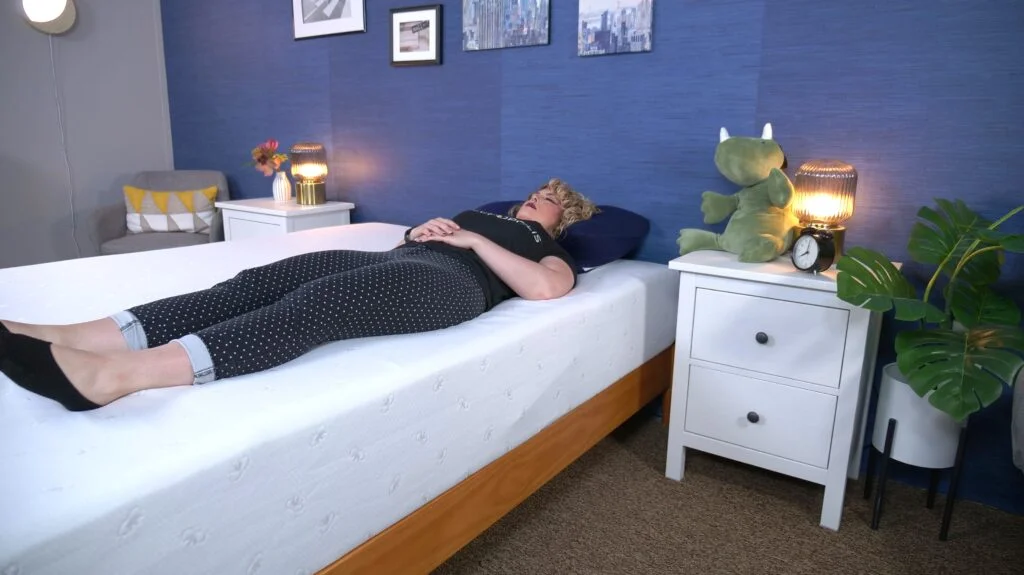
Support and spinal alignment are important for every sleeper but are especially important for sleepers with spinal stenosis. Keeping the spine properly aligned with the neck, shoulders, and hips can help alleviate other back pain, and may even alleviate some discomfort associated with spinal stenosis.
We test for alignment and support by laying on every mattress we review and measuring the amount of support and alignment we feel. Our testers have tested over 300 mattresses, so they are more than capable of looking out for support and spinal alignment when laying on a mattress.
Firmness
Firmness, as we mentioned, is important both when considering body type, but also to maintaining support and comfort across a mattress when sleeping with spinal stenosis. How firm a mattress is can also indicate how pressure relieving and contouring the bed will be. However, it’s not a direct sign of those qualities; firm mattresses can be very pressure-relieving.
We test for the firmness of a mattress using our firmness scale, which ranks mattresses from 1 to 10, with 10 being the most firm. For sleepers with spinal stenosis, we generally recommend a medium to medium-firm mattress. Somewhere between 6 and 7.5 should offer enough support to help you maintain spinal alignment while still being pressure relieving and contouring.
What Mattress Firmness is Best for Spinal Stenosis?
For sleepers with spinal stenosis, we generally recommend a medium to medium-firm mattress. A mattress that falls between 6 and 7.5 should offer enough support to promote proper spinal alignment, which is very important for sleepers with spinal stenosis. However, this firmness level should still offer enough pressure relief and contouring to help alleviate discomfort.
Pressure Relief
As you saw in our mini reviews above, we use a test called a pressure map to measure how well a mattress relieves pressure, and as a result, pain. We simply spread a specialized mat out over the bed and then lie down in all of the different sleeping positions (back, side, and stomach). The mat then sends thermal imaging to a computer screen to create a visual “map” of how much pressure a mattress puts on different areas of the body.
The map is color-coded. Blue means no pressure, green means a little bit of pressure, yellow means moderate pressure, orange means high pressure, and red means very high pressure. When selecting the best mattress for spinal stenosis, we want to see mostly blue all along the back (a little bit of green is okay, too). Take a look below at the Puffy to see why it’s a good bed for spinal stenosis sufferers.
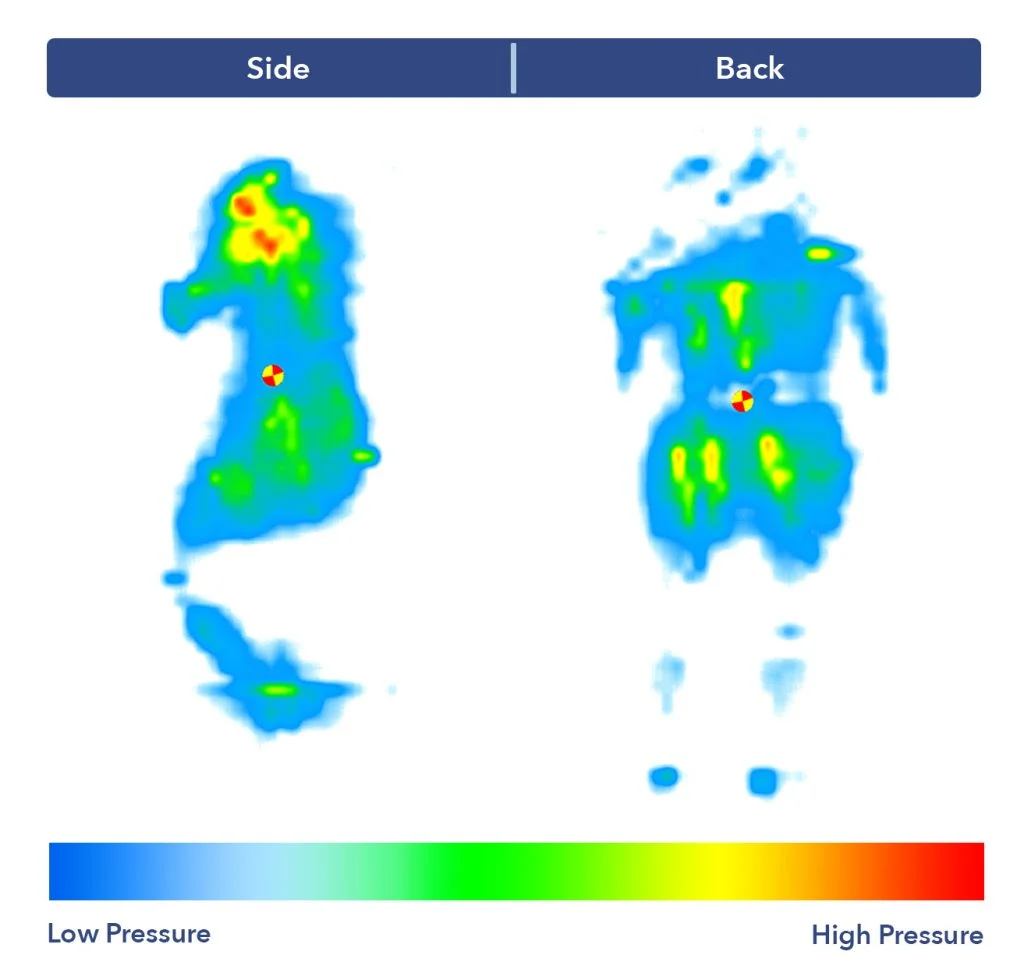
As you can see, there’s some moderate to high pressure along the shoulders while side sleeping, but almost no pressure on the back in both sleeping positions. This tells us that it should be a comfortable mattress for anyone who deals with spinal stenosis.
Edge Support
To test for edge support, we sit and lie on the edge of the bed and, using a yard stick or tape measure, measure how far we sink into its layers.
Anything larger than a 5-inch sink means the mattress doesn’t have good edge support. Edge Support can be crucial for seniors, heavy people, and anyone with chronic pain. These folks all need a little extra support while getting out of bed.
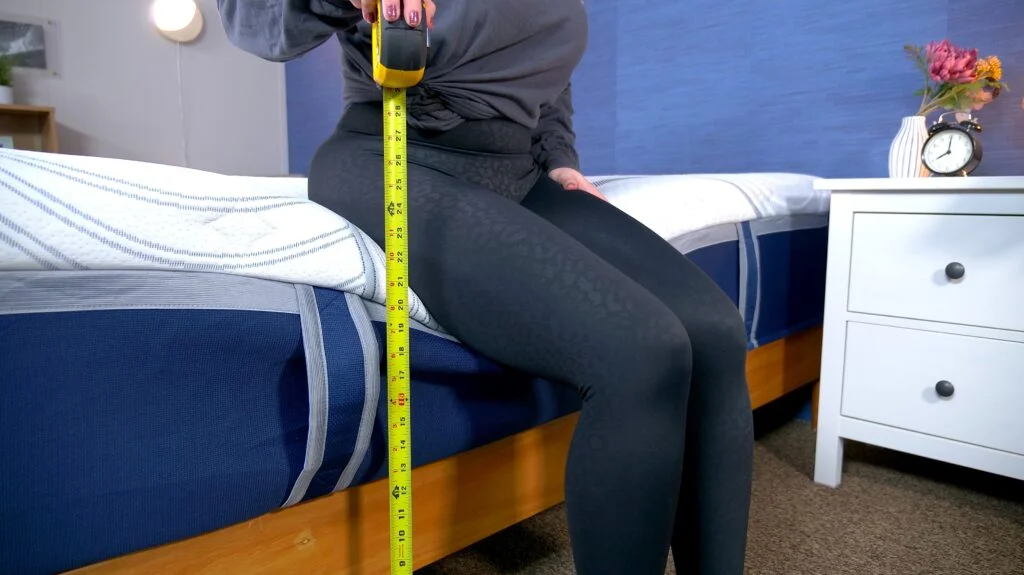
Sleeping Position
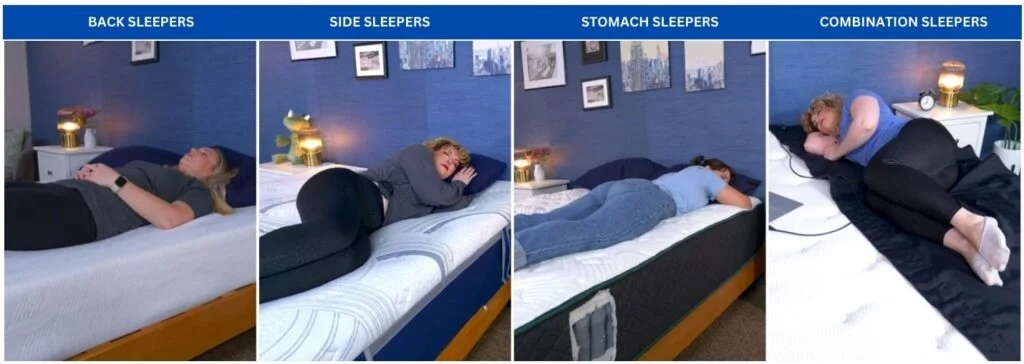
It is always important to consider your sleeping position when buying a new mattress. How you sleep affects the firmness level, support needs, and pressure relief needs you’ll want to look for in a mattress. If you have spinal stenosis, these considerations are all the more important to ensure you can sleep comfortably.
Stomach sleepers generally need a firm mattress that can provide the appropriate support for their spine, allowing them to sleep “on top” of the mattress rather than “inside” it. This is the worst sleeping position for spinal stenosis, as sleeping on your stomach can cause your hips to dip too far into the bed, which can cause the lower back to curve and place the spine in the wrong alignment.
Side sleepers should look for a softer bed with a thick comfort layer that can cradle them while still providing good support through their spine and shoulders.
Back sleepers need a gentle, body-contouring mattress that will help cushion their joints and alleviate pressure on any sensitive spots. Back sleeping puts the least amount of pressure on their spine.
Cooling
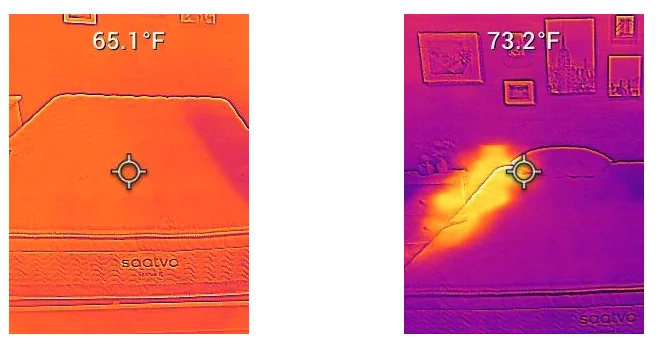
Cooling is important for comfort when sleeping. We test for cooling using a thermal gun, which measures the temperature of a mattress before and after someone has laid on it. The difference between the temperatures is a good measure of how cooling the bed is.
We generally find that a difference under 10 degrees is good cooling, and under 6 degrees is great cooling.
How Much Should I Spend on a Spinal Stenosis Mattress?
How much you decide to spend on your next mattress completely depends on your budget, and there are beds that fit into each budget. Since you’re dealing with chronic pain everyday, we recommend investing in a mattress that will offer you the support, pressure relief, durability, and firmness you need to sleep comfortably at night, which is typically between $1,600–$2,100. Depending on when you decide to buy a mattress, check out our coupons and deals to help you save some money.
Motion Isolation
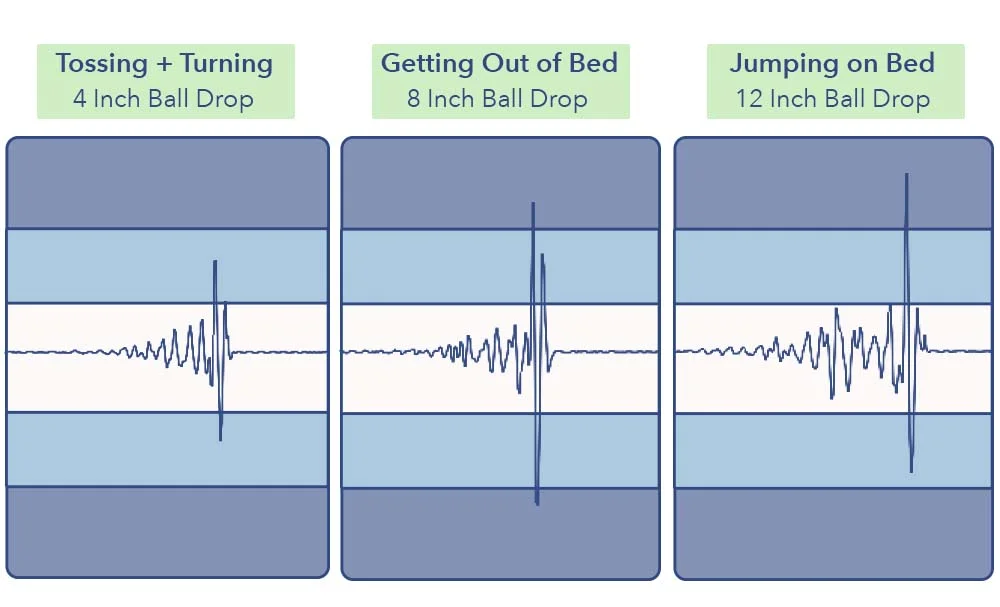
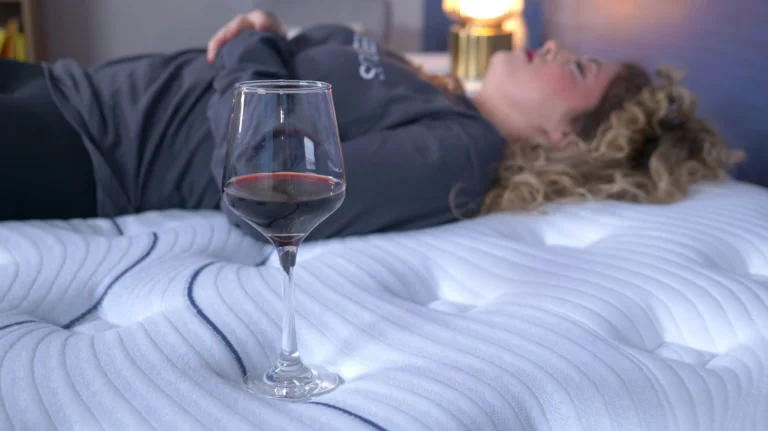
Moving around on your mattress can be extremely painful if you struggle with spinal stenosis. You need to look for a mattress that’s able to absorb the movement without letting you sink too far into the bed. Another factor to think about is if you share your bed with a partner, kid, or pets. The last thing you want is to be woken up in the middle of the night because of someone else’s sleep schedule.
We test each of our mattresses for their motion isolation ability by performing two tests. First, we use the drop ball test to measure the movement felt across the mattress. We then use a seismograph to measure the levels of movement as our testers move through different sleeping positions. If there are sizable vibrations, it could worsen your spinal stenosis since you’re likely to feel your partner tossing and turning.
Our second test involves a glass of red wine. We place the wine glass on one side of the bed and have our testers toss and turn normally on the other side. Whether the glass gets knocked over or not gives us an immediate answer on whether this bed has good motion isolation.
Best Mattress Type for Spinal Stenosis

Memory Foam
The hugging and contouring feel of memory foam helps distribute your weight evenly for amazing pressure relief. Foam is a great mattress type for those with spinal stenosis. However, we recommend staying away from the budget foam beds, as they may not offer the support you’ll need in your spine. The main con of foam is the trapped heat sleepers often experience. Look out for foam beds with cooling layers, gels, or foams for more breathability.
Hybrid
Because they contain both foams and springs, hybrid mattresses offer a balance between support and contouring, which makes them a great option for those with spinal stenosis. These beds are typically great at relieving pressure while also keeping your spine aligned through the night.
Innerspring
Innerspring mattresses offer a lot of bounce compared to traditional foam beds because of the springs and coils found within the construction. While they tend to be supportive, they don’t offer a ton of pressure relief, which could be an issue if you struggle with spinal stenosis.
Latex
If you’re looking for pressure relief but also an organic mattress, a latex bed might be the best fit for you. These types of mattresses are naturally ,cooling and very durable, making them a great option for those with spinal stenosis. You should be able to sink into the latex foam layers without misaligning your spine or experiencing unnecessary pressure points.
Pillow Top Mattresses for Spinal Stenosis
If you struggle with spinal stenosis, we recommend looking into pillow top mattresses. They come in all types and sizes — some with cooling gels and some with a heating component for extra pressure relief. Most pillow top mattresses simply have an extra layer of support, specific to help with chronic pain. This added layer keeps your hips and spine aligned all while hugging and contouring you for maximum comfort.
If you’re specifically looking for a pillow top mattress, check out our best pillow top mattress picks.
Company Policies
Sleep Trials
An extended sleep trial will give you a chance to test your new bed in the comfort of your own home and figure out whether it’s suited for you or not. Typically, manufacturers offer around 60 to 100 days, but some can allow shoppers to test the mattress for up to a whole year. This gives you plenty of time to break in your new mattress and see if it relieves the pain and tension in your spine.
Warranties
Mattress warranties are helpful when it comes to customer protection. Each company’s warranty is different. That’s why we recommend reading the fine print. Typically, though, warranties protect the customer from damages upon delivery or mattress defects. It’s also important to note that warranties give you an idea of how long the mattress should be durable for. We recommend looking at warranties that range from 10–20 years and staying clear of anything under five years.
Shipping
Every mattress selected on this list offers free shipping with your mattress purchase so you’t have to worry about that added cost. For an extra cost, however, some mattress companies offer a service called white glove delivery which involves them hand delivering the bed, setting it up, and removing your old mattress. This is a great option if you struggle with any chronic pain like spinal stenosis or if you’re alone when the mattress is delivered.
Shipping can also be very expensive if you’re purchasing internationally, so we also looked into some of the best Canadian mattresses to help you navigate international mattress shopping.
Signs to Replace Your Mattress
- You start feeling extreme pain
- Your mattress starts to visibly sag
- You see any lumps in the mattress
- You sleep super-hot even in a cool room
- If it’s had over eight years of regular sleep
Accessories to Help Your Spinal Stenosis
Pillows
Using a wedge pillow to lift your knees a little higher will help relieve any added pressure onto your spine. Another option is putting the pillow in between your knees in a fetal position if you’re a side sleeper.
Mattress Toppers
If you don’t have the budget to buy a new mattress, a new mattress topper is a great option to give you a little extra support for your spine without breaking the bank. Mattress toppers are often latex or foam, but some toppers — such as the ones made by Tempur-Pedic — are specially designed to relieve any unwanted pressure points while still keeping your spine aligned throughout the night.
Does an Adjustable Base Help With Spinal Stenosis?
Many sleep experts have started recommending adjustable bases for spinal alignment. By elevating your feet, you’re taking some pressure off of your spine through a zero-gravity position. Most mattresses are compatible with adjustable bases, and you can check out what our experts selected as some of the best adjustable beds.
Tips for Sleeping Better with Spinal Stenosis
Sleeping with spinal stenosis can be challenging, and you may experience pain or discomfort. However, there are a couple of things that you can do to help you get a better night’s sleep.
- Physical Therapy: Physical therapy aimed at relieving back pain and discomfort due to spinal stenosis may include stretching and strength training. This can help alleviate some of the pain you’re experiencing and allow you to sleep more comfortably.
- Pain Relievers: Over-the-counter pain relievers can help relax muscles across the back, which may help alleviate pain and tension. We recommend consulting a doctor about dosage and the type of pain reliever before taking any medications.
- Acupuncture: Acupuncture involves placing very small needles across the body, which is believed to help release muscle tension and relieve pain, tension, and discomfort. Again, we recommend consulting with a medical professional first.
- Sleep with a Pillow: Sleeping with a pillow under your lower back can promote healthier spinal alignment and help you maintain a healthy curve across the spine. Placing a pillow under the knees may also help spinal alignment and help relieve some discomfort.
FAQs
Can a good mattress help spinal stenosis?
While a mattress can’t treat the condition, a suitable bed can help alleviate the symptoms.
Can spinal stenosis get worse because of the wrong mattress?
An unsuitable mattress can put too much pressure on your spine or create unnatural curves, which can lead to increased discomfort and higher pain levels.
Can memory foam worsen your spinal stenosis?
On the contrary, memory foam is very pressure relieving and can help alleviate pain associated with spinal stenosis. However, it’s a softer material, and you’ll want to make sure the bed also has enough support to keep your spine neutrally aligned.
What causes spinal stenosis?
Spinal stenosis can be caused by a number of things, but common causes are herniated disks, spine injuries, bone spurs, and occasionally tumors.
What mattress is best for spinal stenosis?
Each kind of mattress can offer different traits that may help you sleep with spinal stenosis. Overall, we generally find that foam or hybrid mattresses offer the necessary support and pressure relief.
What is the best sleeping position for spinal stenosis?
Sleeping on your back with your knees elevated by a pillow can help alleviate some discomfort. Sleeping in a fetal position may also help to stretch the spine in a way that can help alleviate some pain.
What mattress firmness is best for spinal stenosis?
We suggest looking at medium-firm mattresses (6.5 on the firmness scale) for spinal stenosis. This can help relieve pressure points at the hips, back, shoulders, and neck while maintaining a healthy spinal alignment.
How We Chose These Mattresses
Our team of Certified Sleep Science Coaches has reviewed more than 300 products in our mattress lab, running each one through tests such as pressure-mapping and measuring motion transfer with a seismometer. From there, we give every bed an overall score based on materials, motion isolation, support, and more. We also factor in brand performance with categories such as value and warranty.
Because sleepers with spinal stenosis are dealing with pain, we made sure to choose mattresses that excelled in the area of pressure relief. At the same time, we focused on beds that still offered enough support to keep the spine aligned. Click here to learn more about our methodology. And if you’re still not sure of the right mattress, you can take our mattress quiz to be shown a selection of mattresses curated to your sleep preferences.
Sources
MedlinePlus (n.d.). Back Pain. Retrieved from https://medlineplus.gov/backpain.html
C. Lillis (2019, July 22). Spinal stenosis: Everything you need to know. Retrieved from https://www.medicalnewstoday.com/articles/325817#symptoms
Mayo Clinic Staff (2018, March 08). Spinal stenosis. Retrieved from https://www.mayoclinic.org/diseases-conditions/spinal-stenosis/symptoms-causes/syc-20352961
R. Kalff, C. Ewald, A. Waschke, L. Gobisch, and C. Hopf (2013, September 13). Degenerative Lumbar Spinal Stenosis in Older People. Retrieved from https://www.ncbi.nlm.nih.gov/pmc/articles/PMC3784039/
A. Truszczyńska, J. Drzał-Grabiec, M. Płszewski, K. Rąpała, A. Tarnowski (2015). Posture of Patients With Lumbar Spinal Canal Stenosis. Retrieved from https://pubmed.ncbi.nlm.nih.gov/24968797/
University of Virginia (n.d.). Cervical Stenosis. Retrieved from https://med.virginia.edu/neurosurgery/services/spine-surgery/cervical-stenosis/
A. A. Sama, F. P. Girardi, F. P. Cammisa Jr. (2011, July 26). Lumbar Spinal Stenosis – An Overview. Retrieved from https://www.hss.edu/conditions_lumbar-spinal-stenosis.asp
R. Staehler (2017, October 25). Mattresses and Sleep Positions for Each Back Pain Diagnosis. Retrieved from https://www.spine-health.com/wellness/sleep/mattresses-and-sleep-positions-each-back-pain-diagnosis
- Mayo Clinic. Spinal Stenosis – Symptoms and Causes. Mayo Clinic. Published March 28, 2023. https://www.mayoclinic.org/diseases-conditions/spinal-stenosis/symptoms-causes/syc-20352961
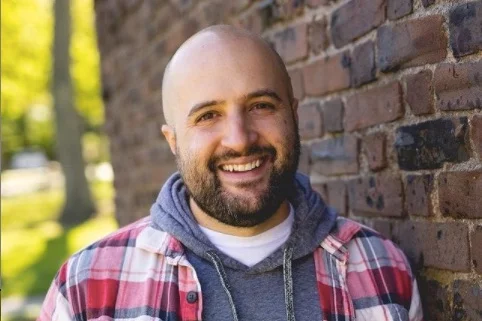
Dan Caffrey
Managing Editor
About Author
Dan is a Performance Editor and Certified Sleep Coach at Sleepopolis, where he writes and edits mattress roundups to give readers the most up-to-date information on sleep products. In 2020, Dan earned his MFA In Playwriting from UT Austin, and his plays have been seen around the country in Chicago, Austin, Washington D.C., and elsewhere. He’s also a pop-culture fanatic, having written for publications such as The A.V. Club, Consequence, Pitchfork, and Vox. He co-hosts two popular horror podcasts on the Bloody Disgusting Podcast Network — The Losers’ Club: A Stephen King Podcast and Halloweenies: A Horror Franchise Podcast. When he’s not catching up on the latest King novel, you can find Dan in and around Brooklyn walking his dog Hank, seeing a play with his wife, and going to way too many concerts.
Combination Sleeper
